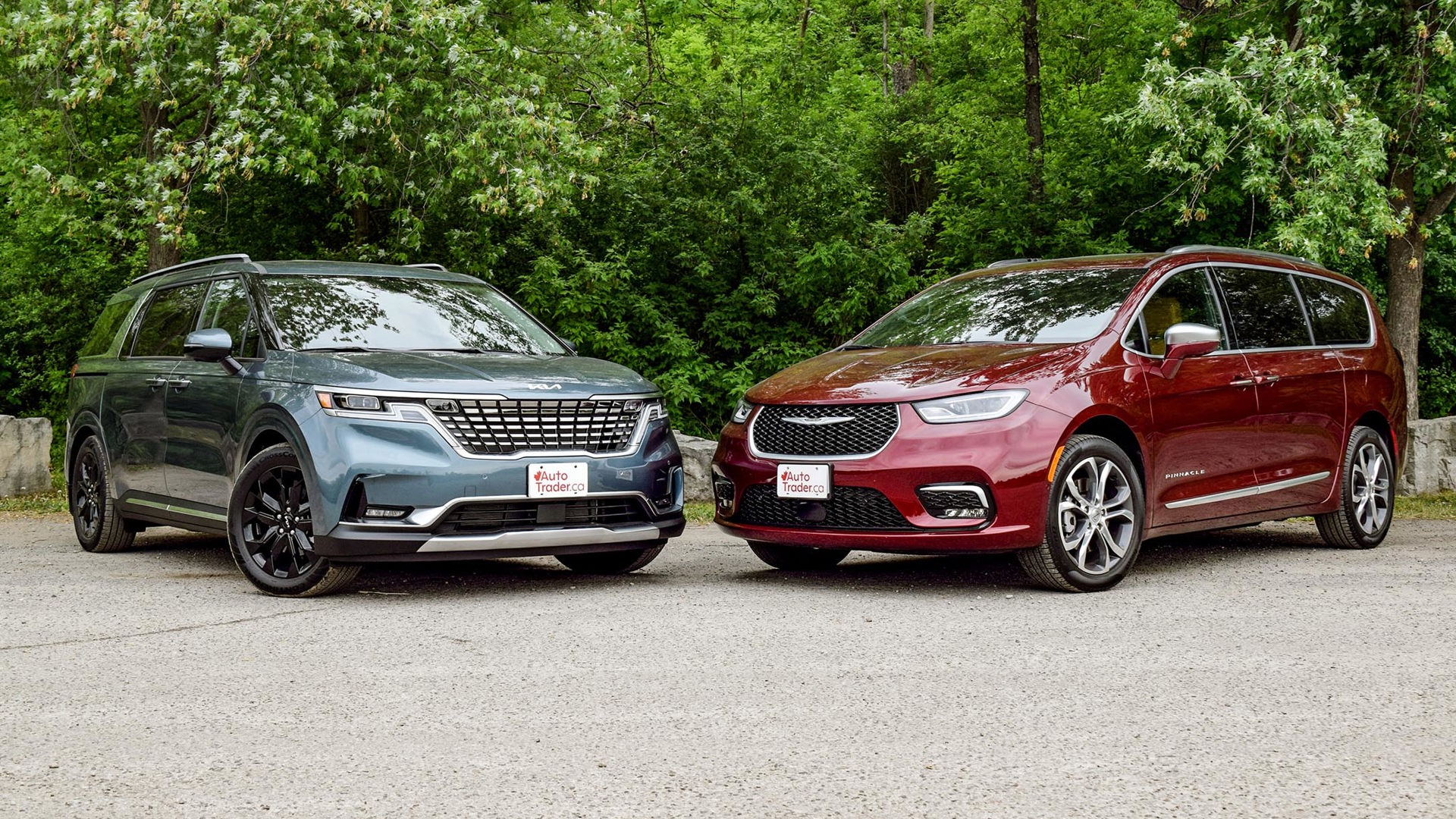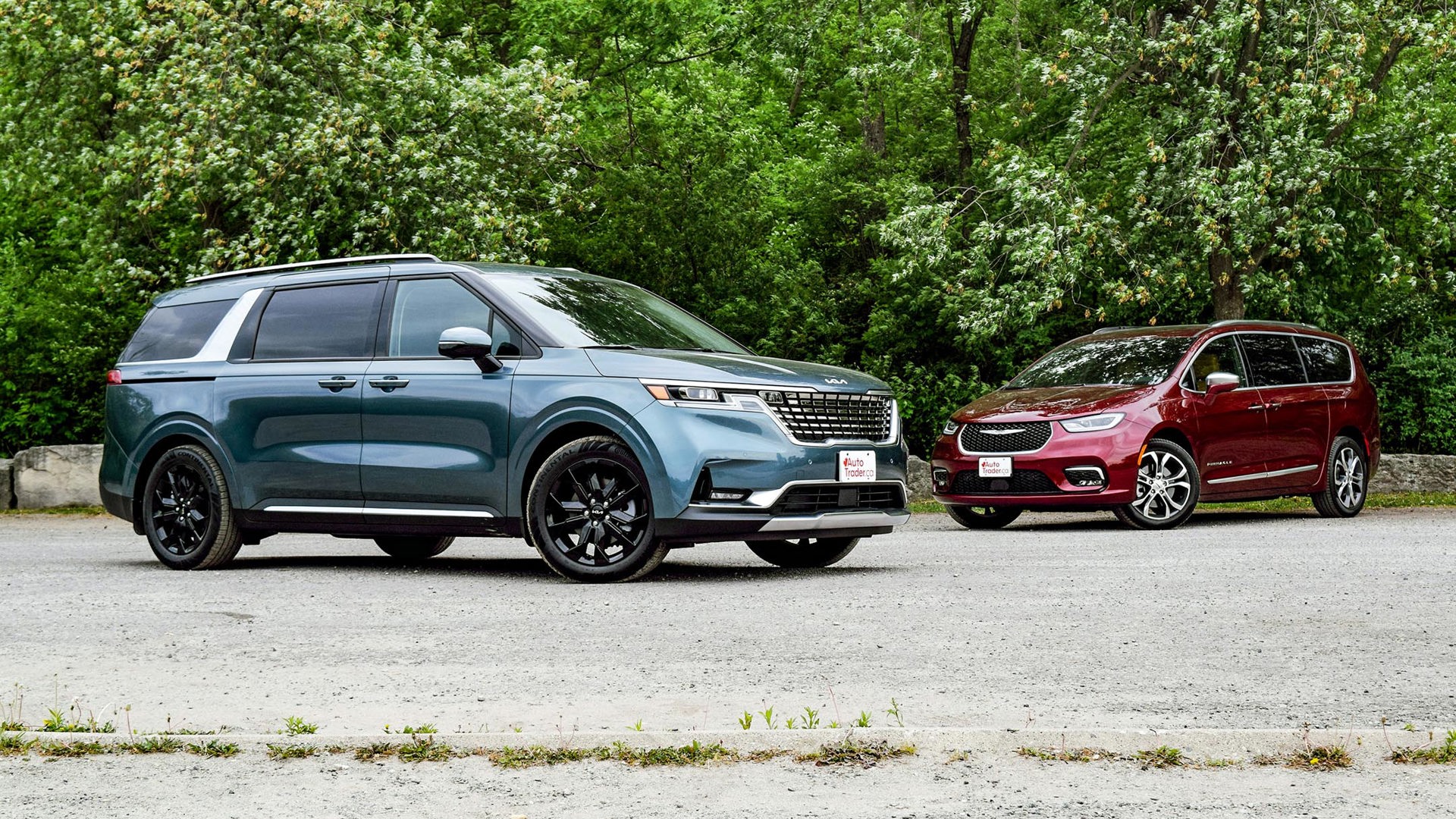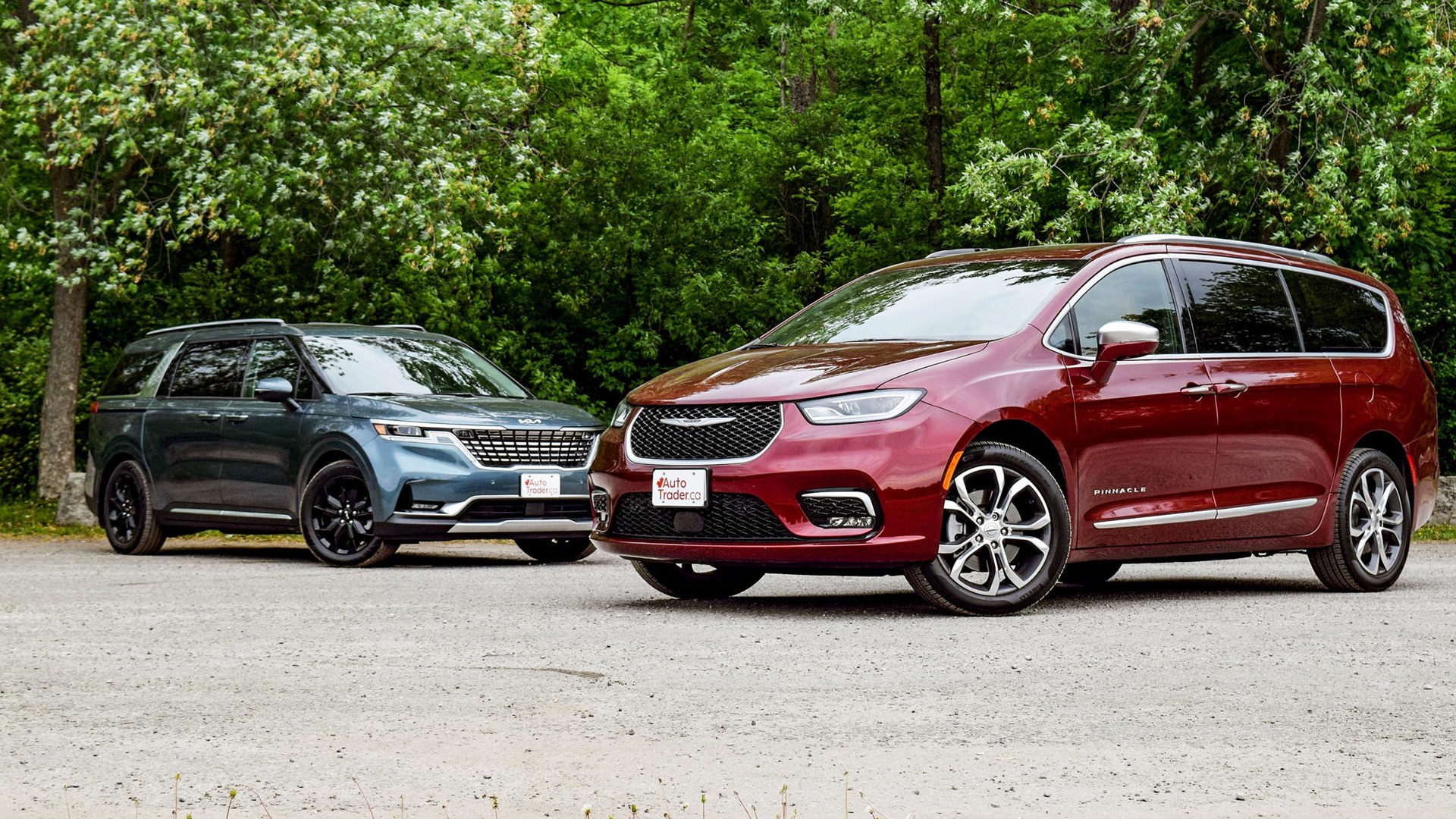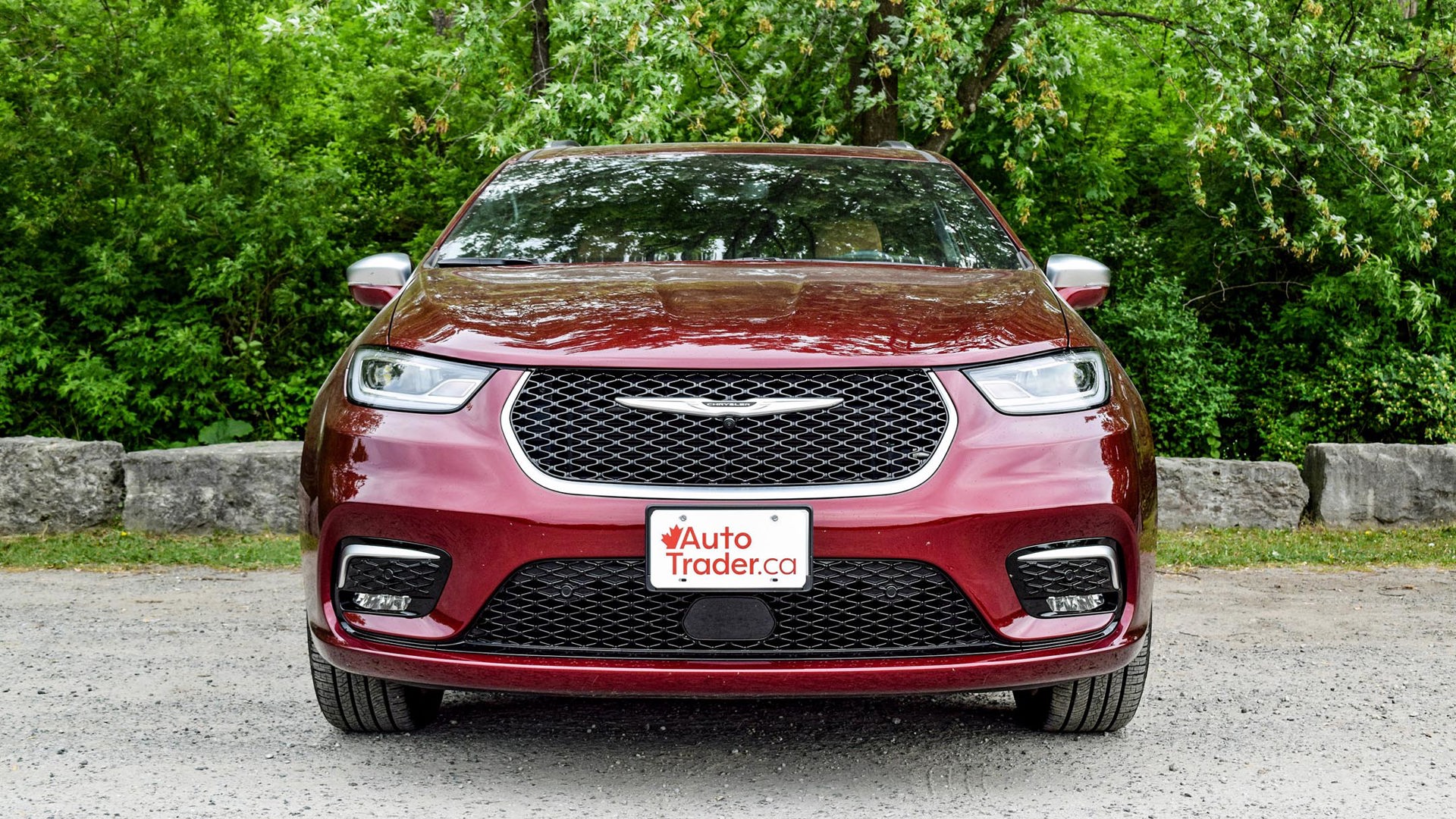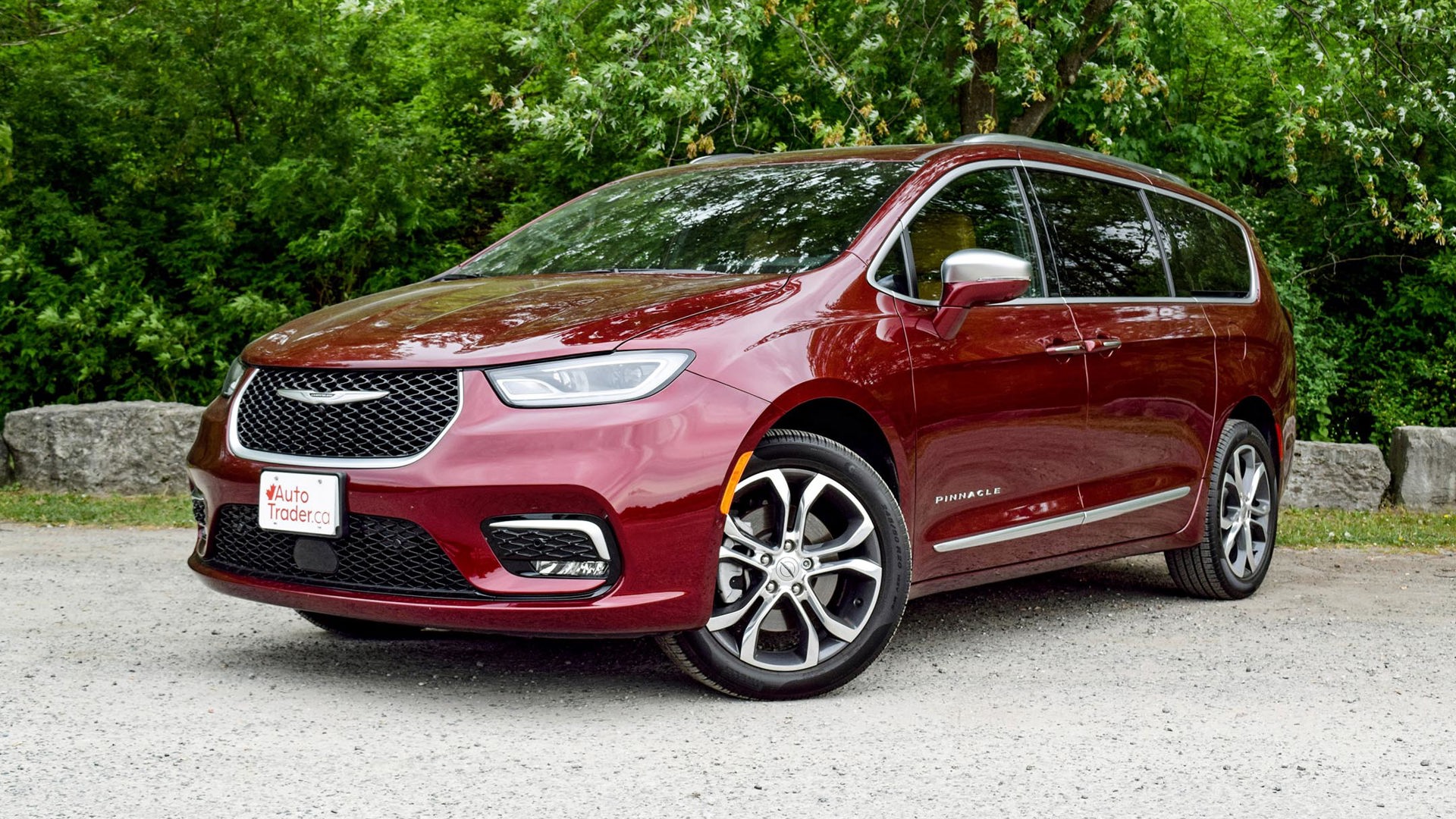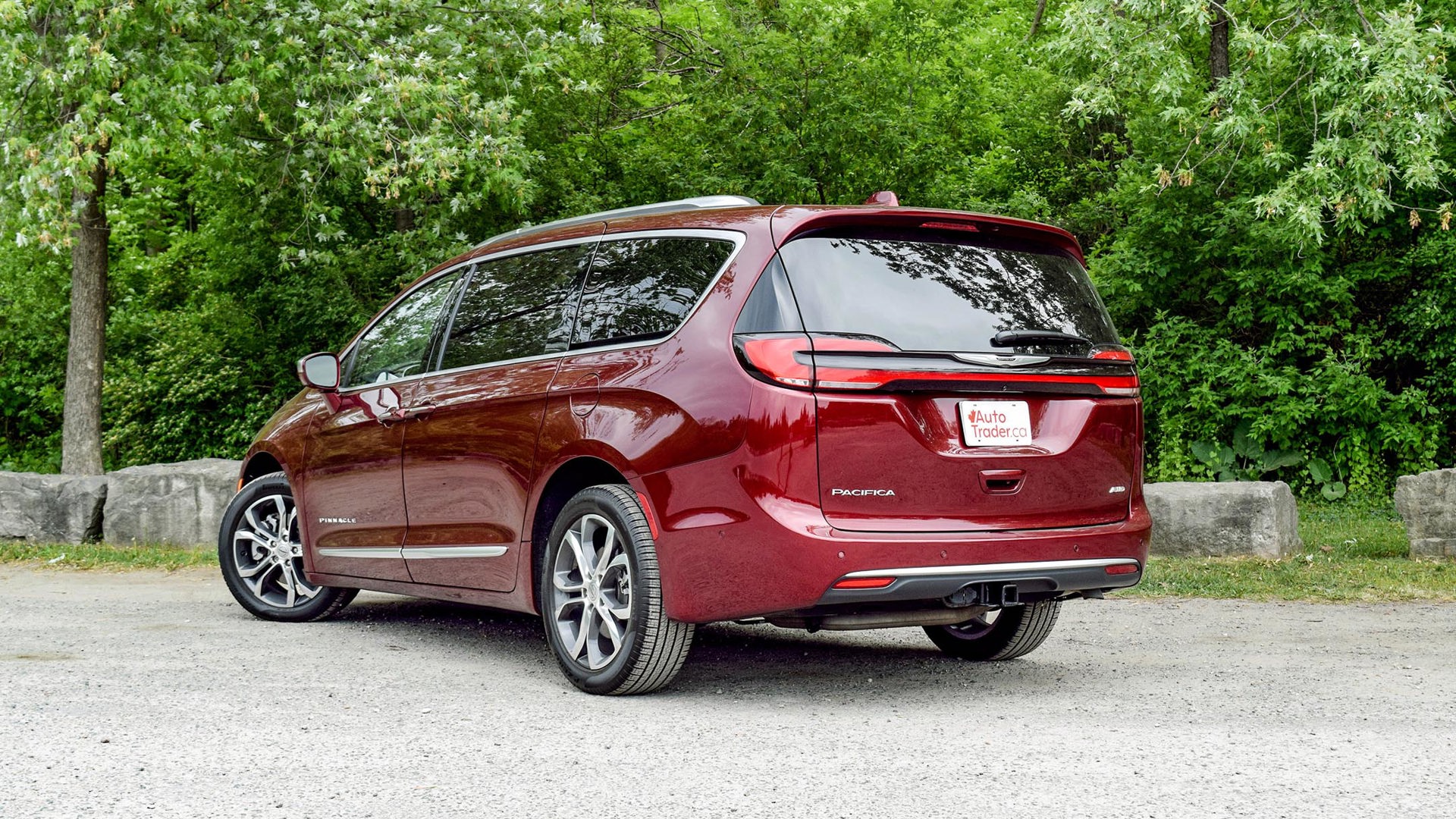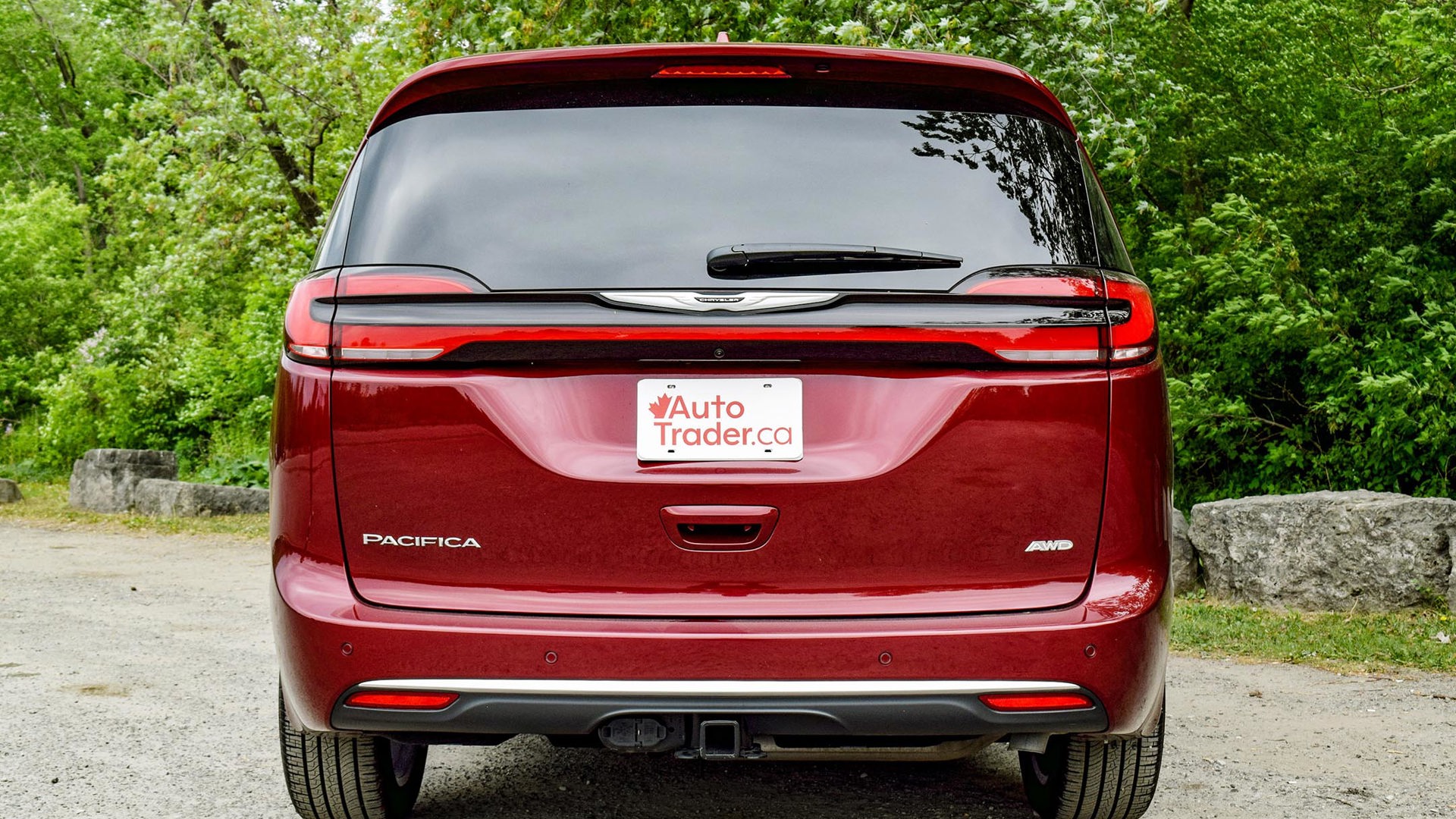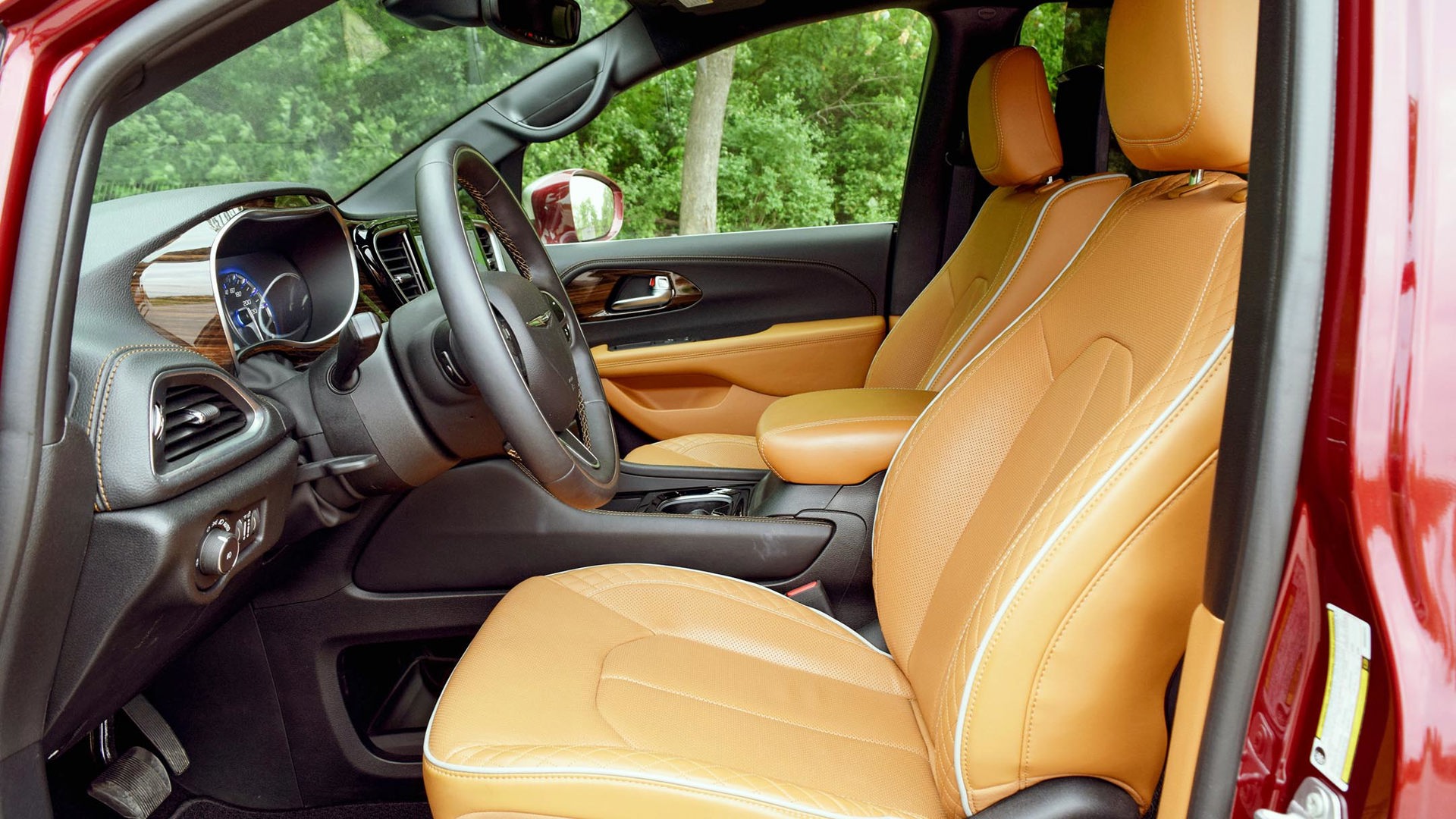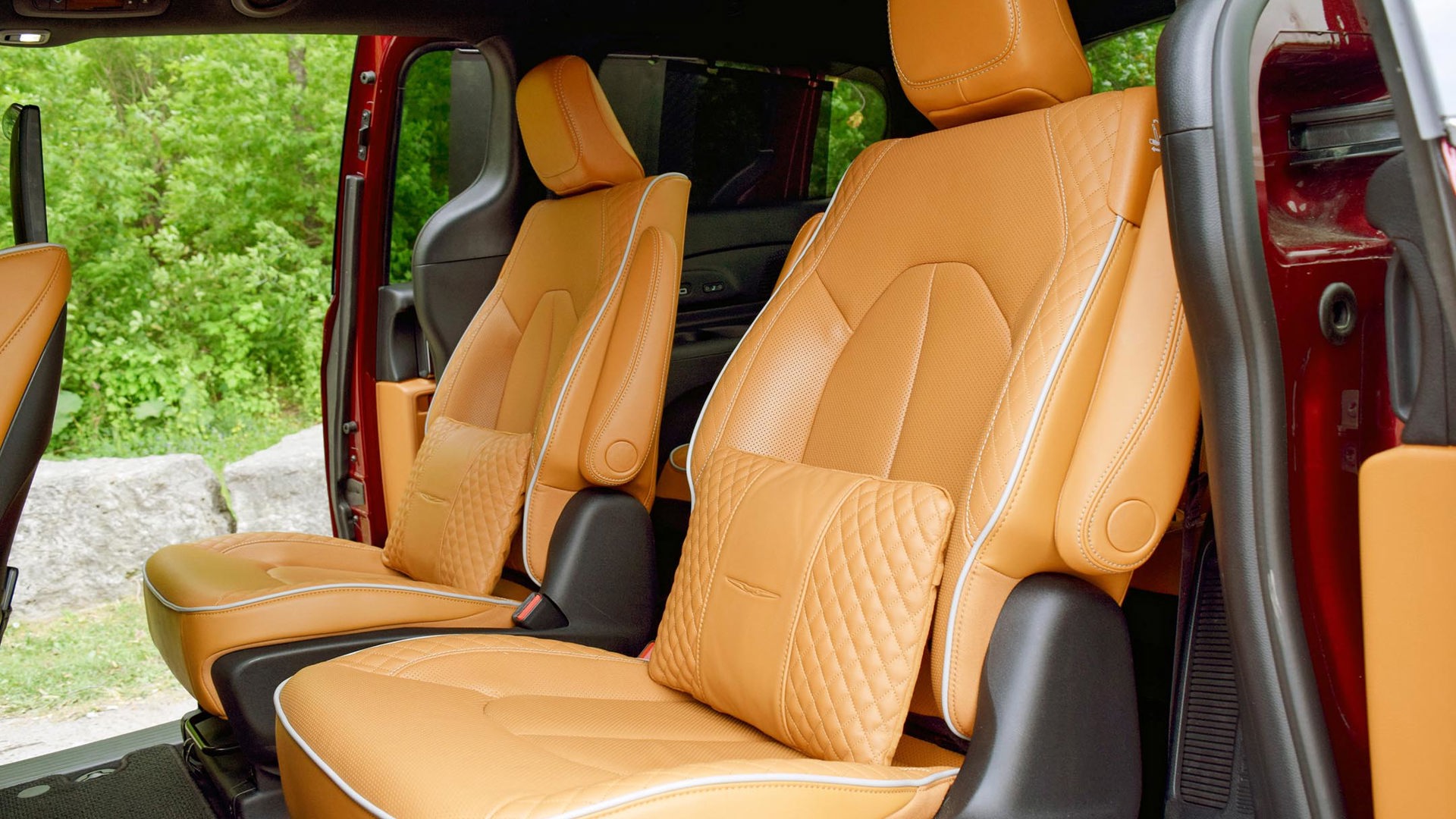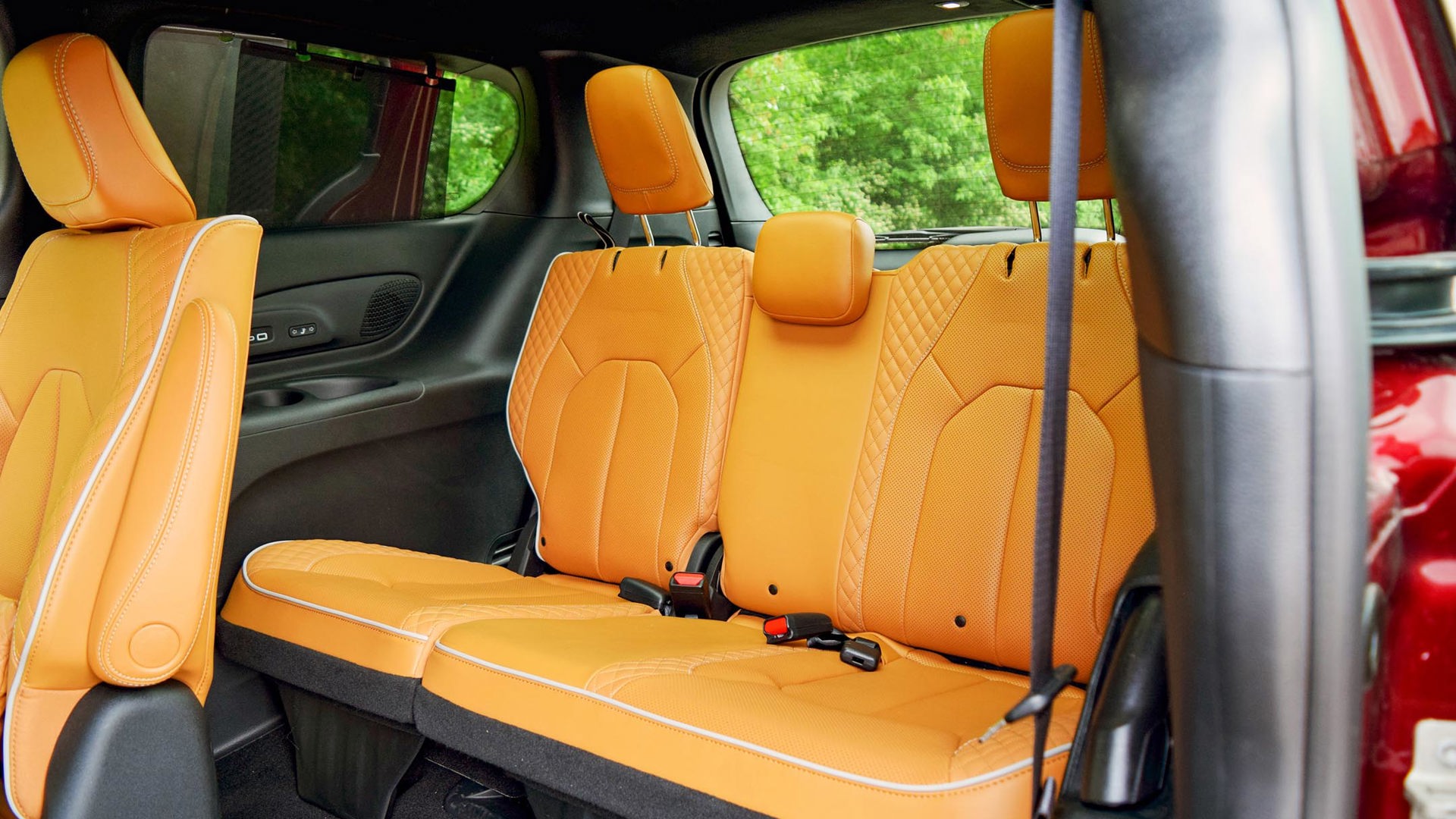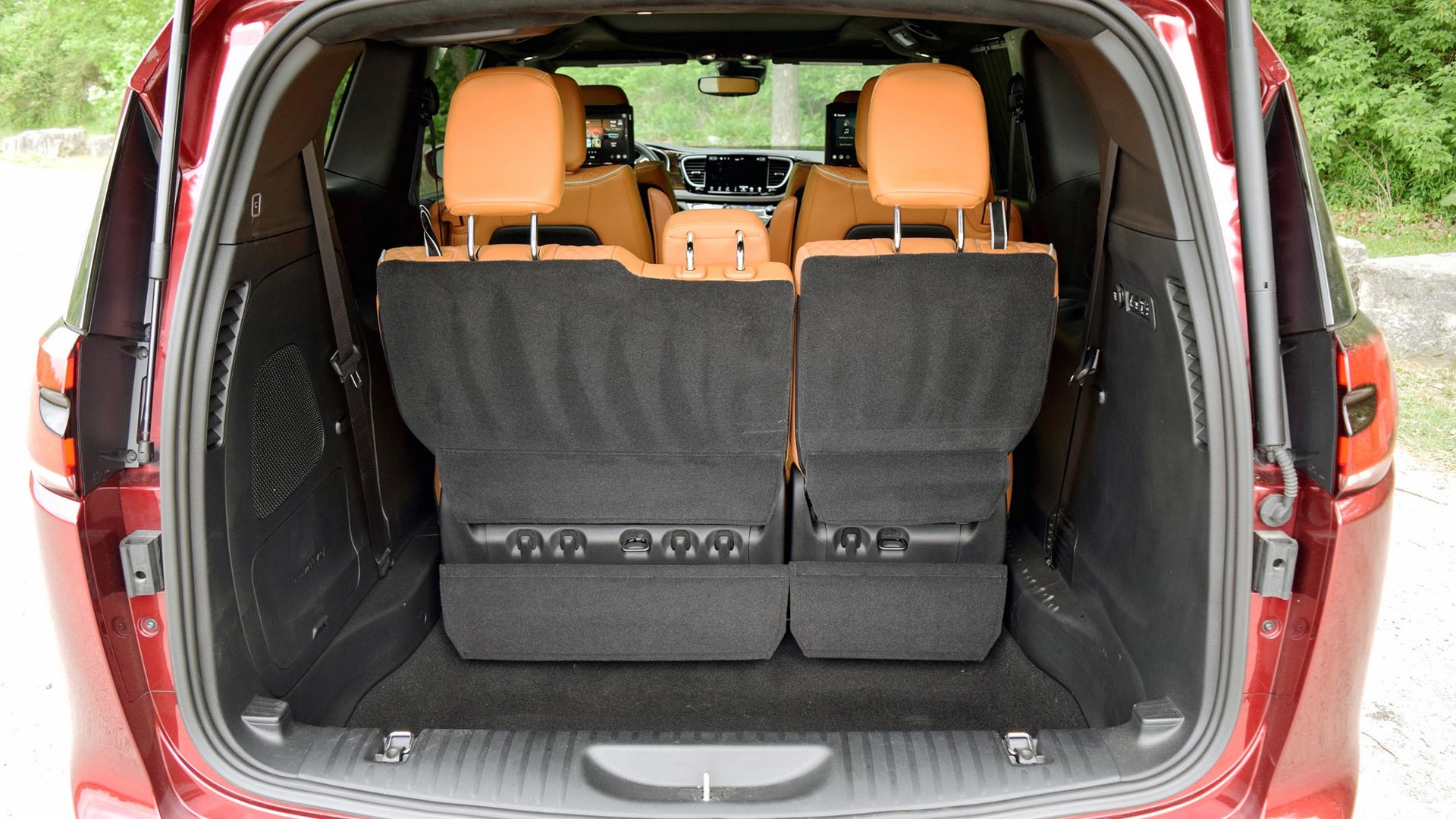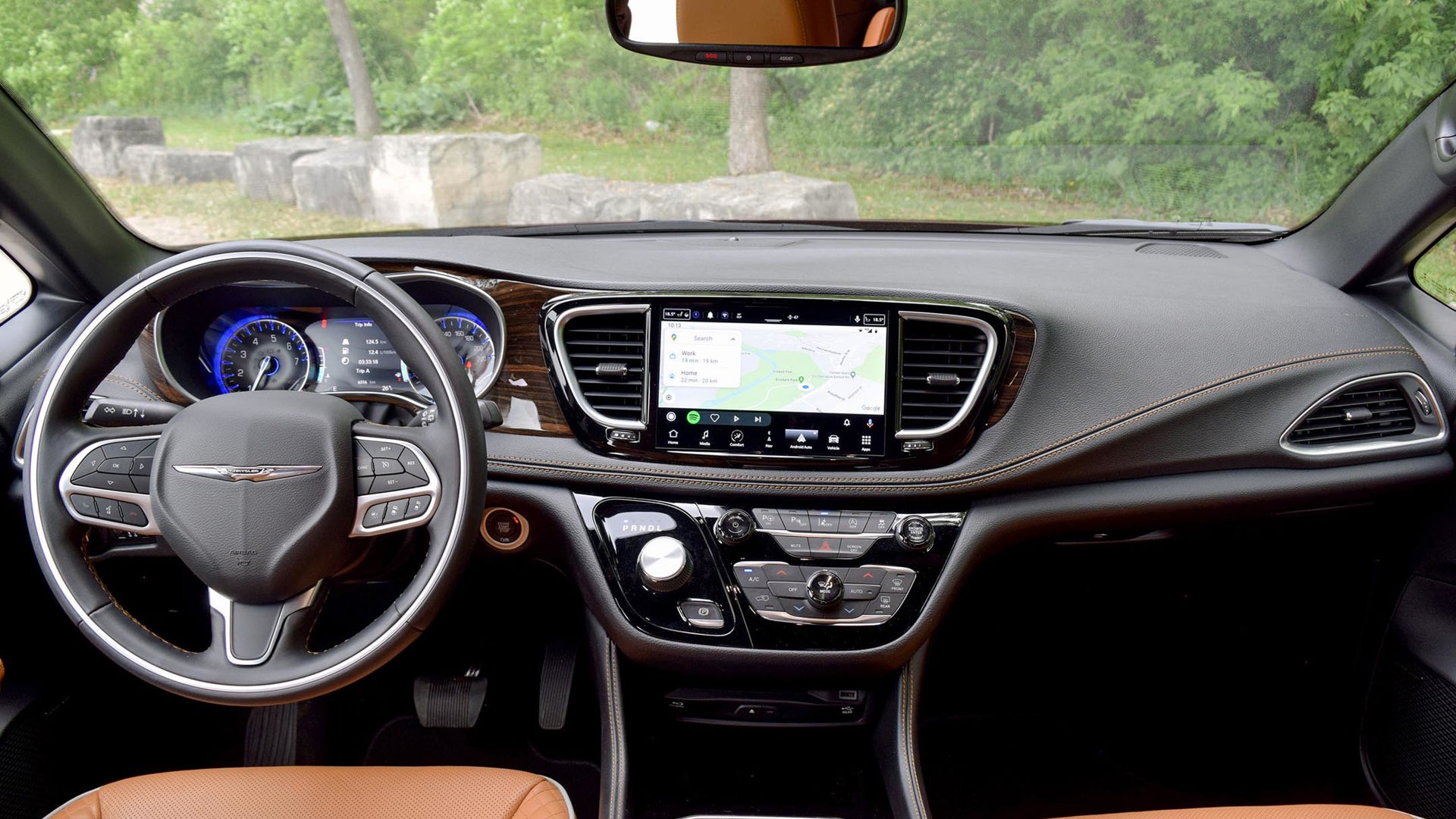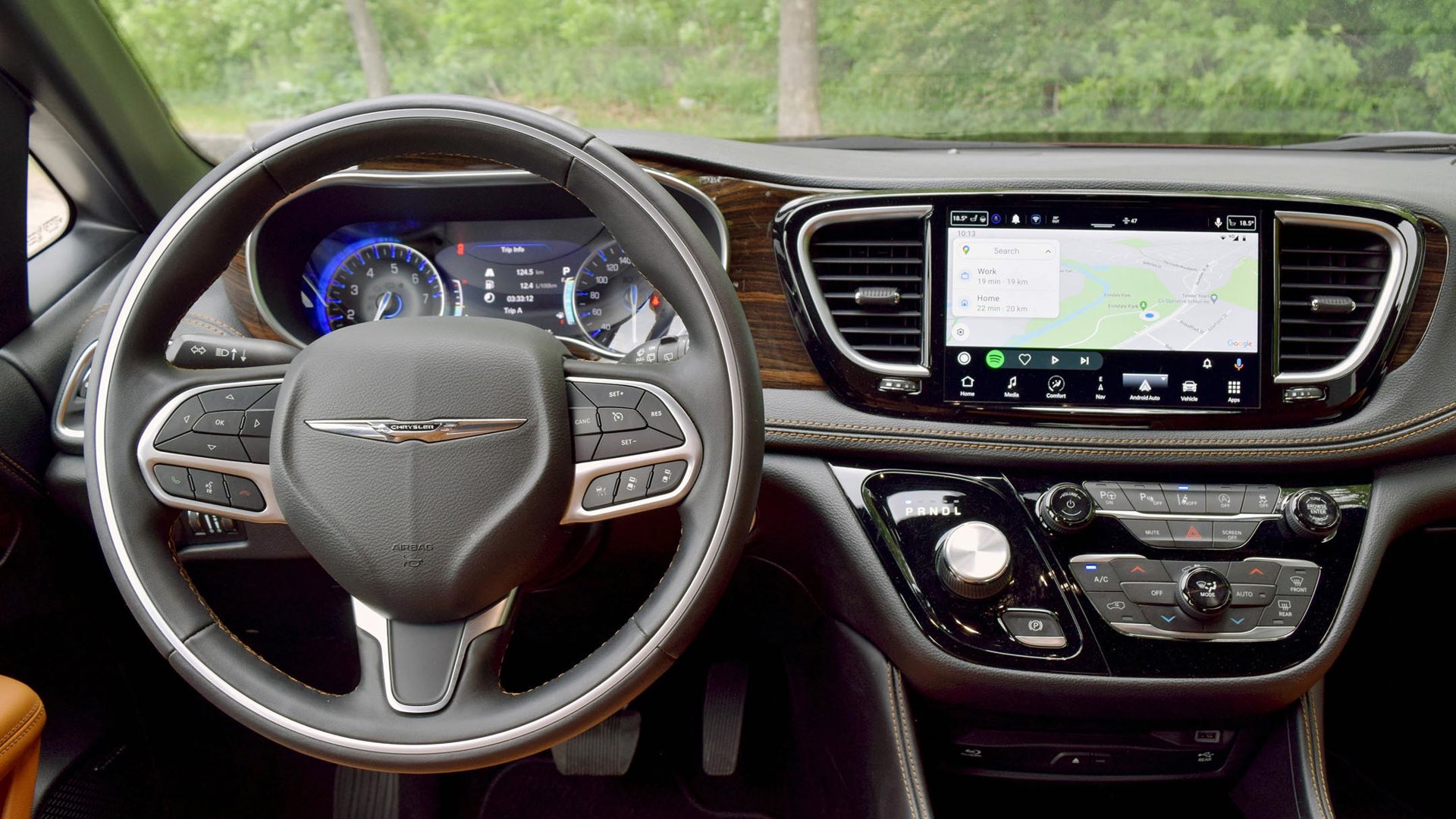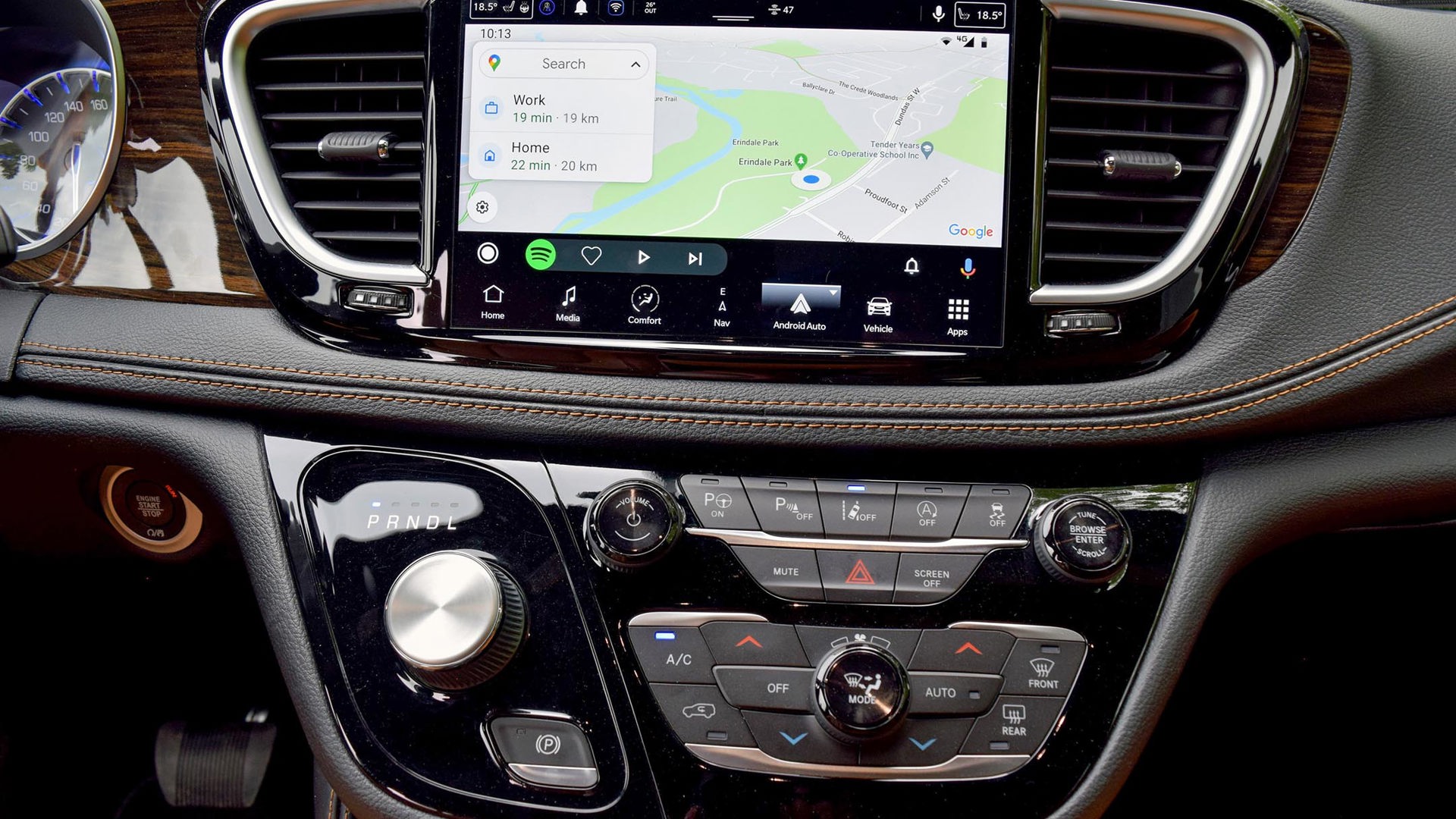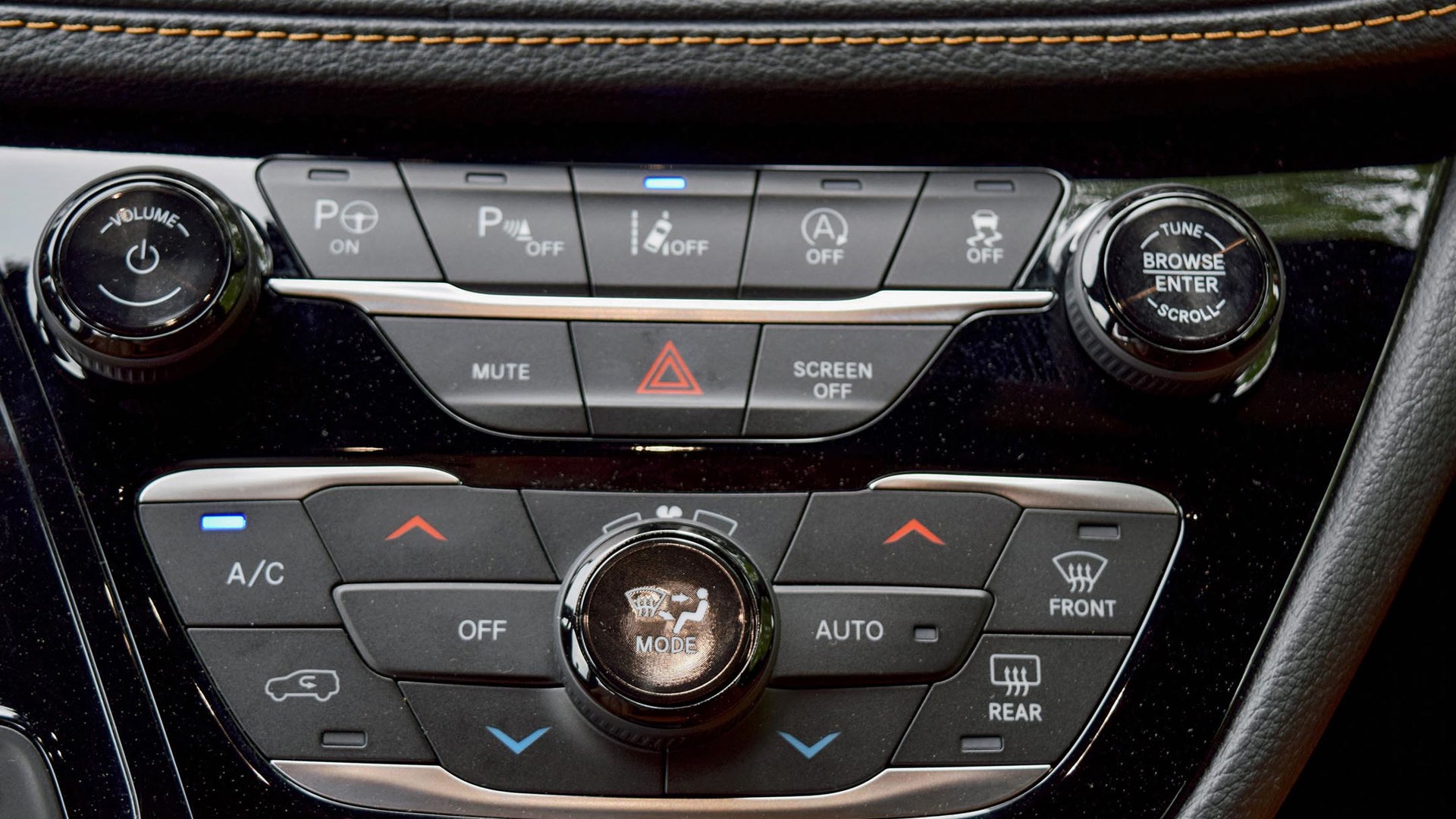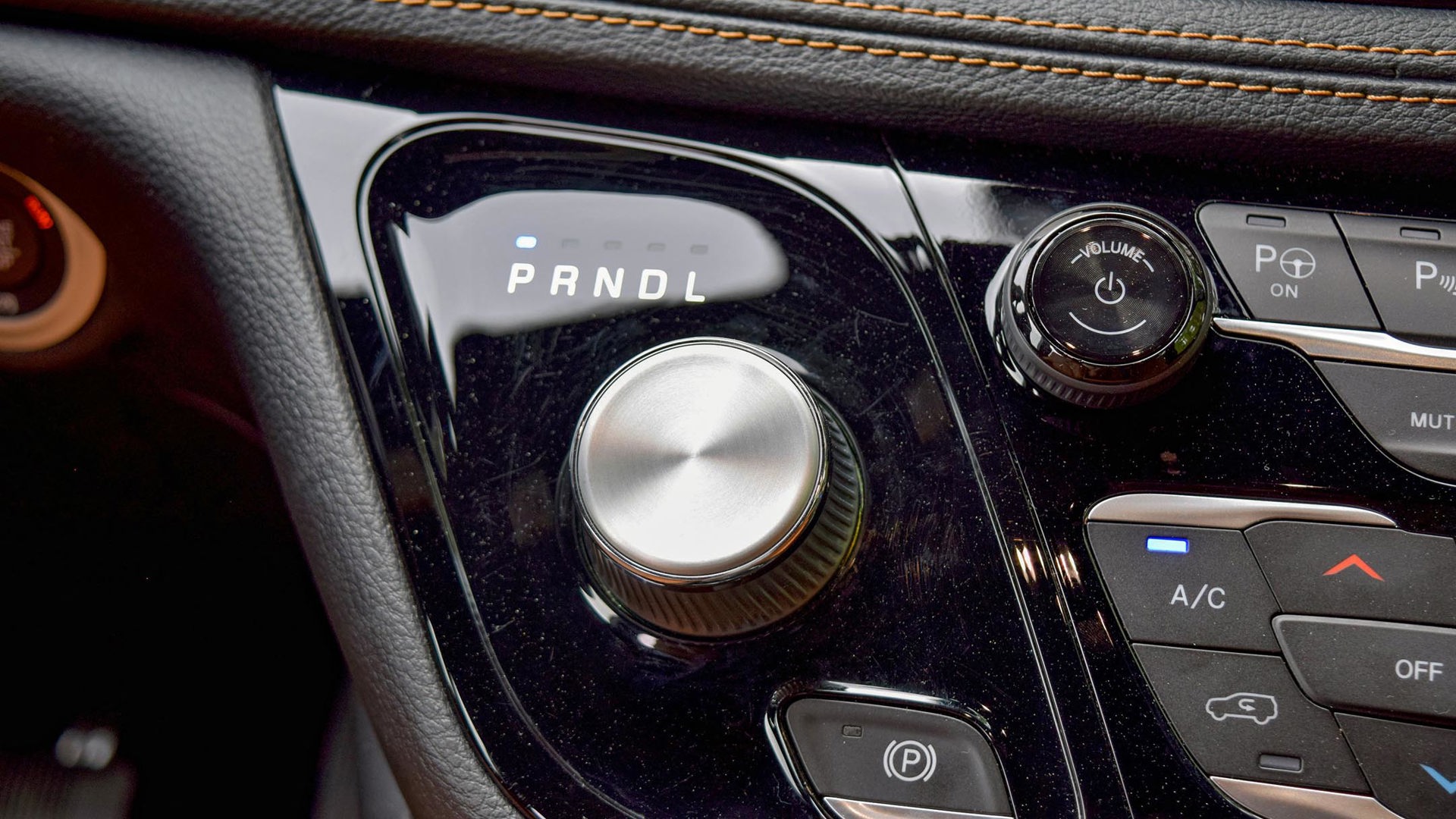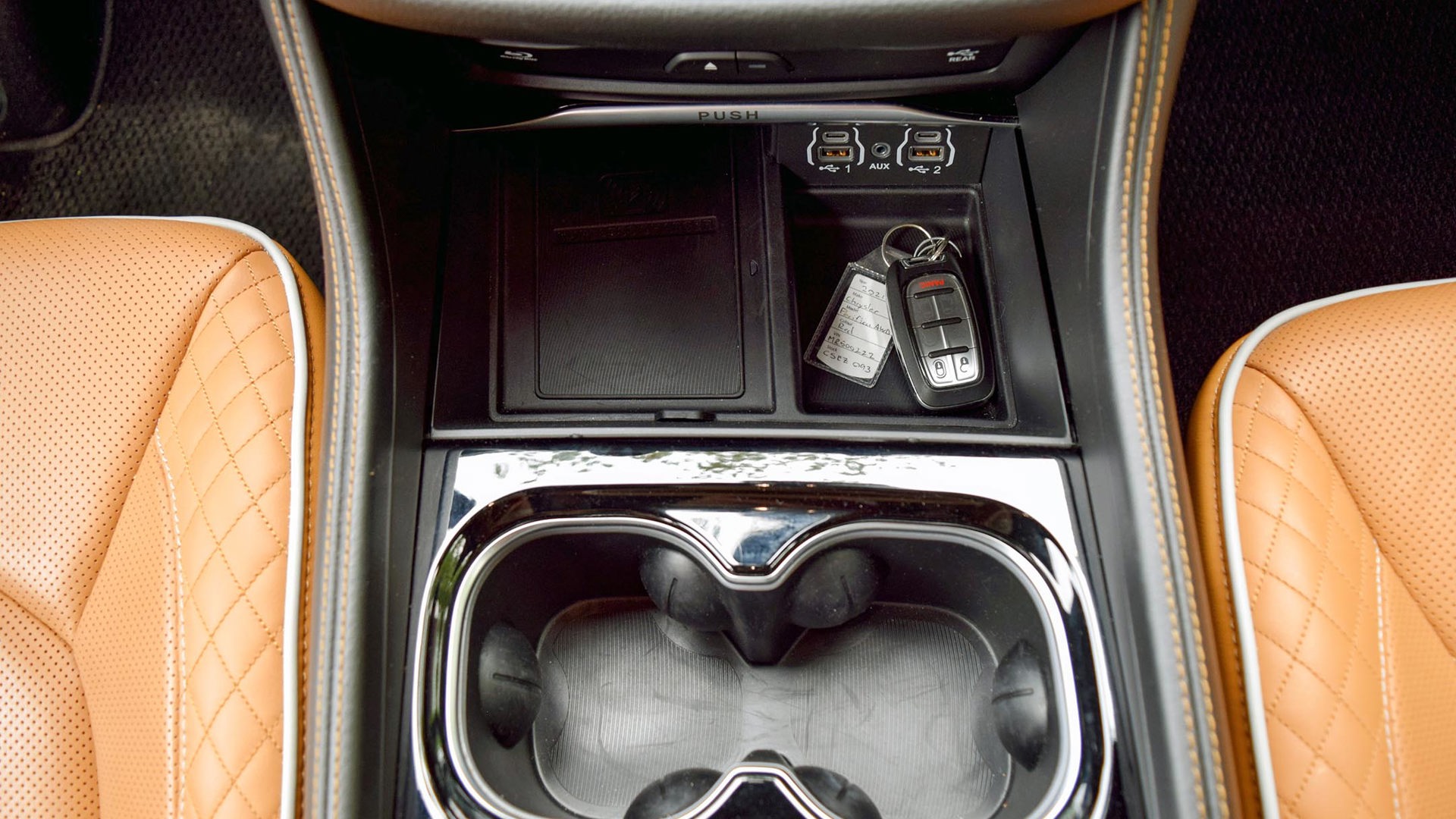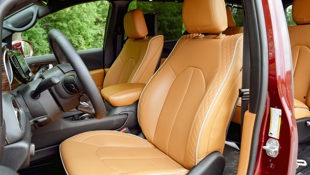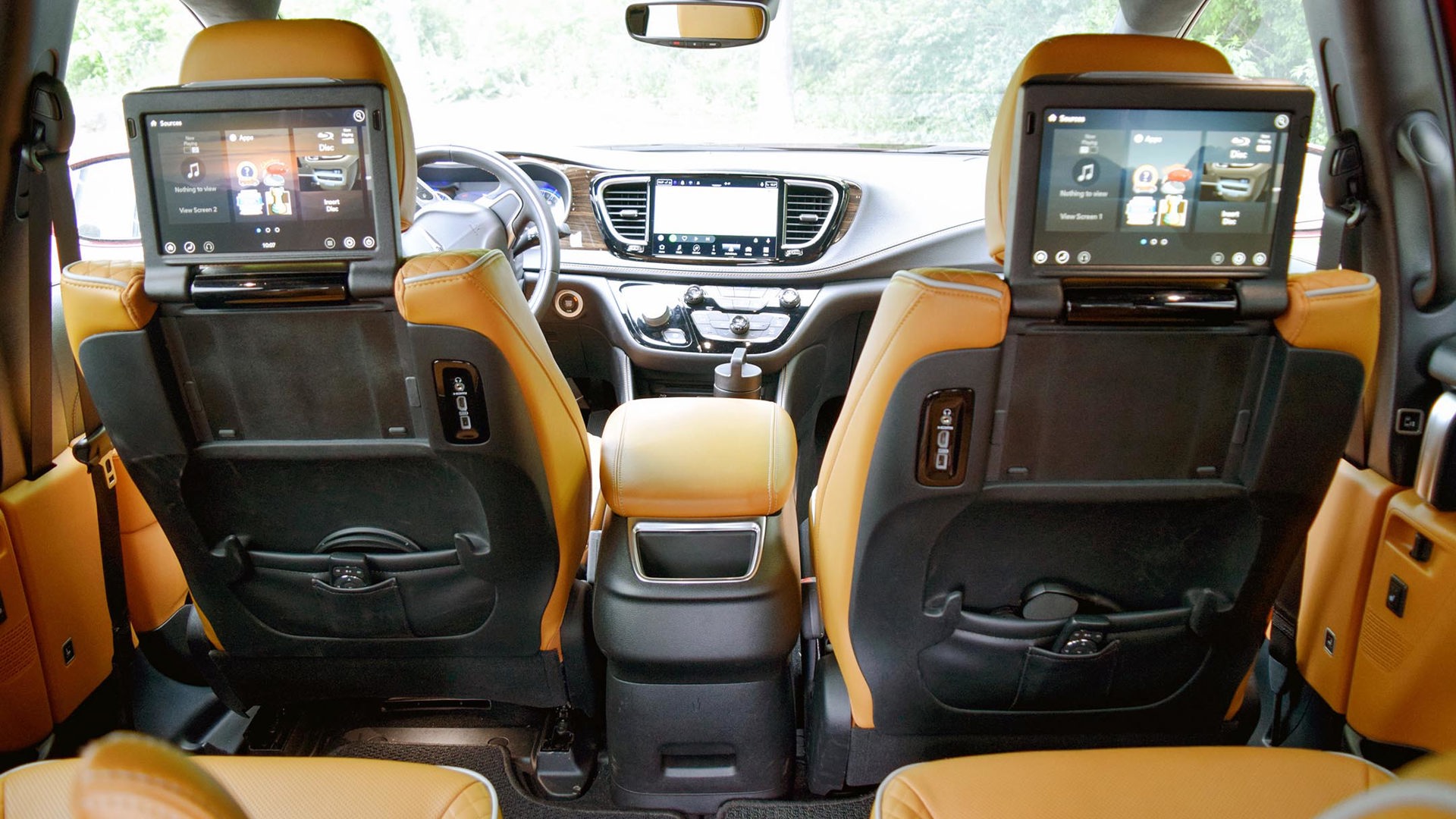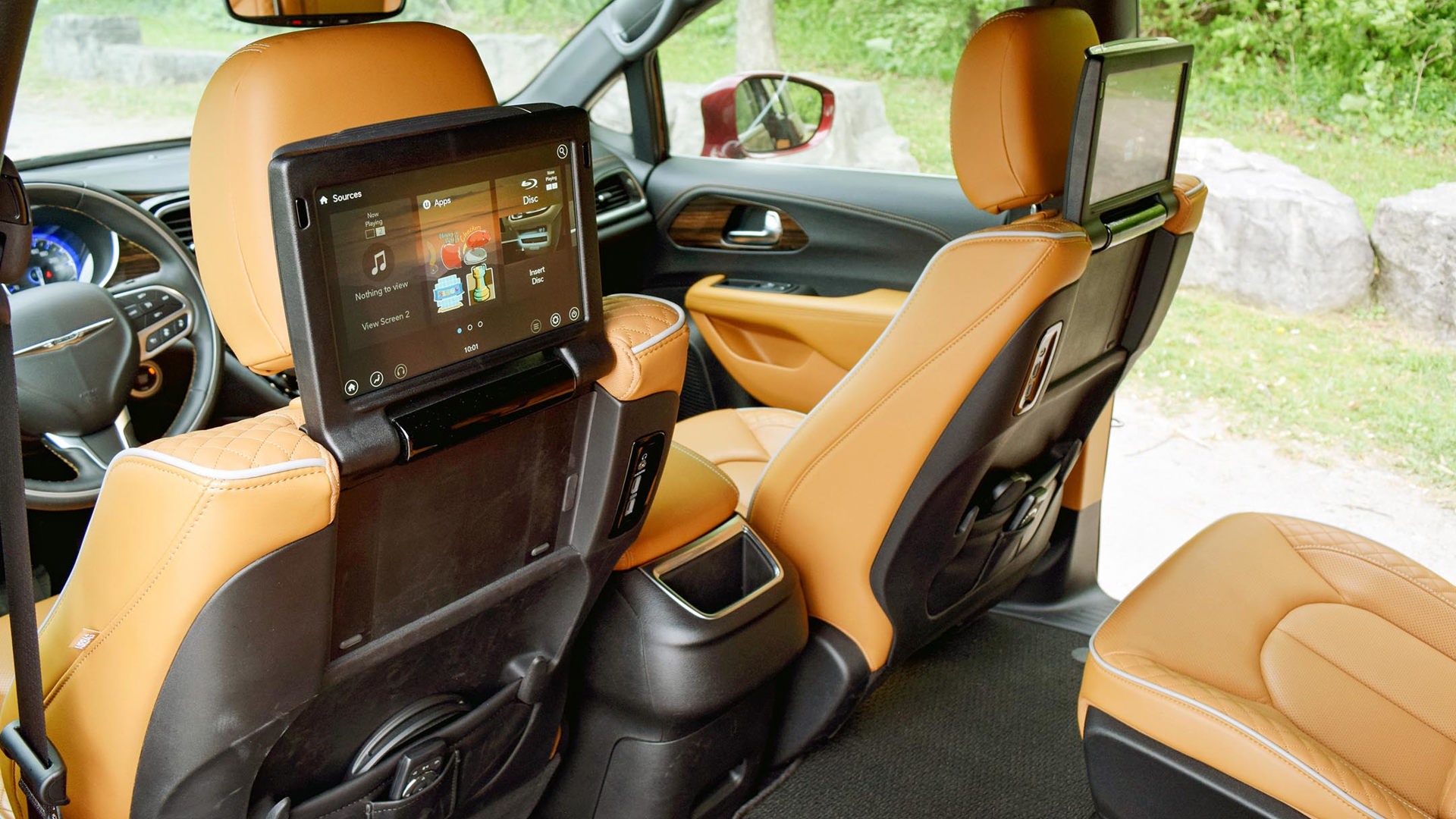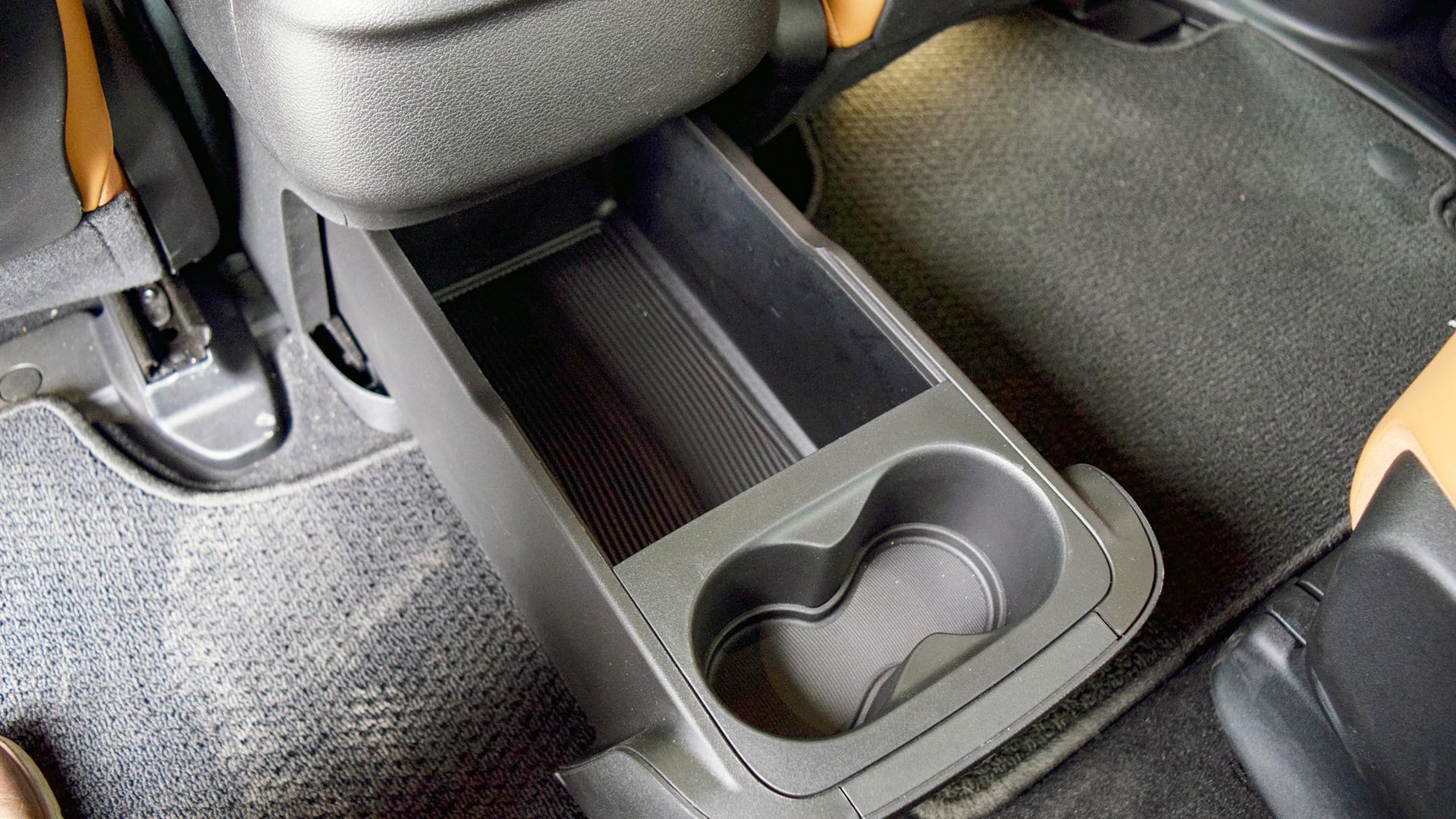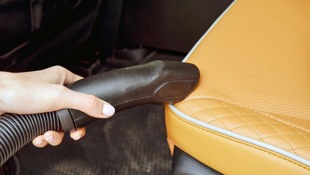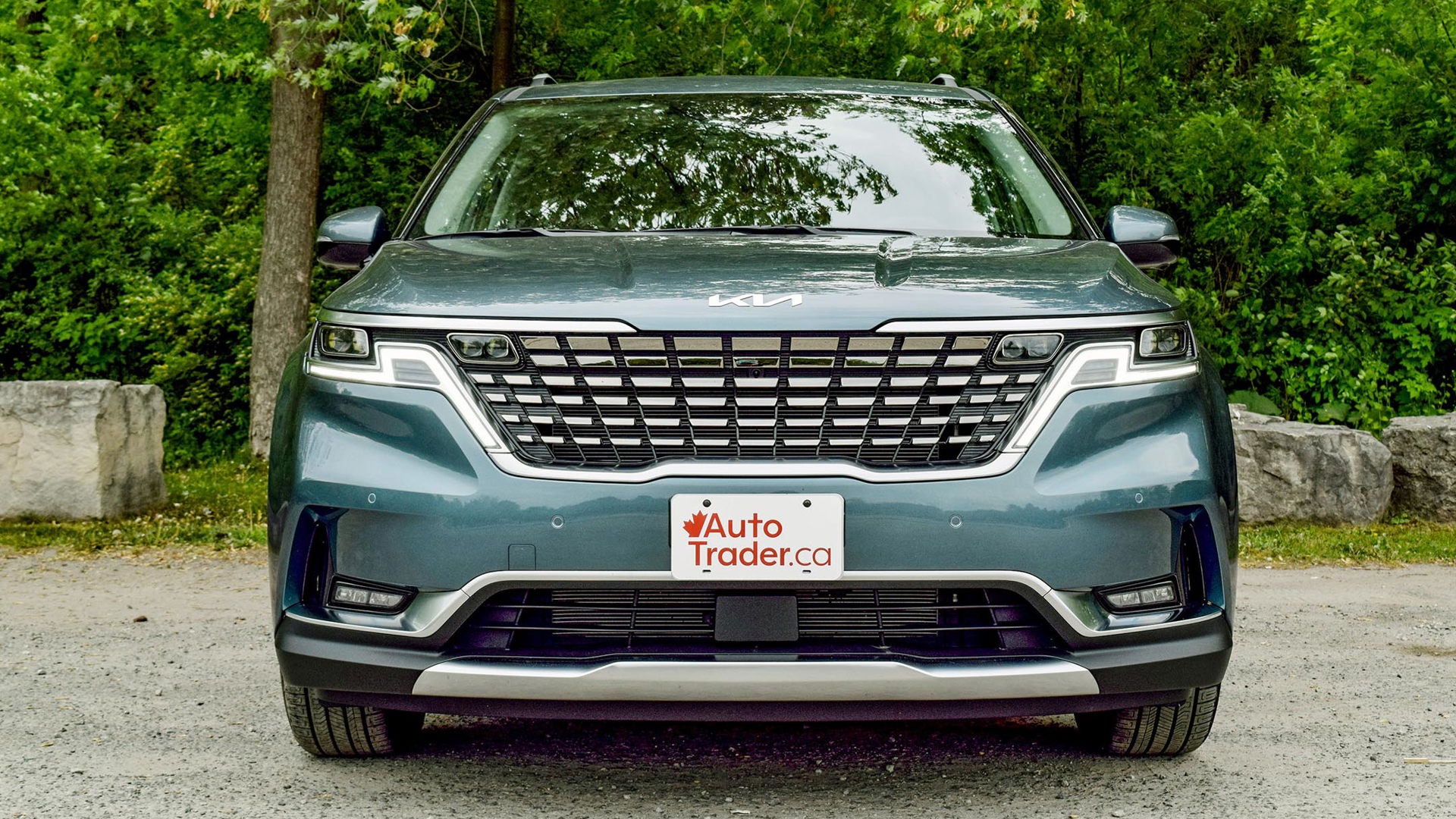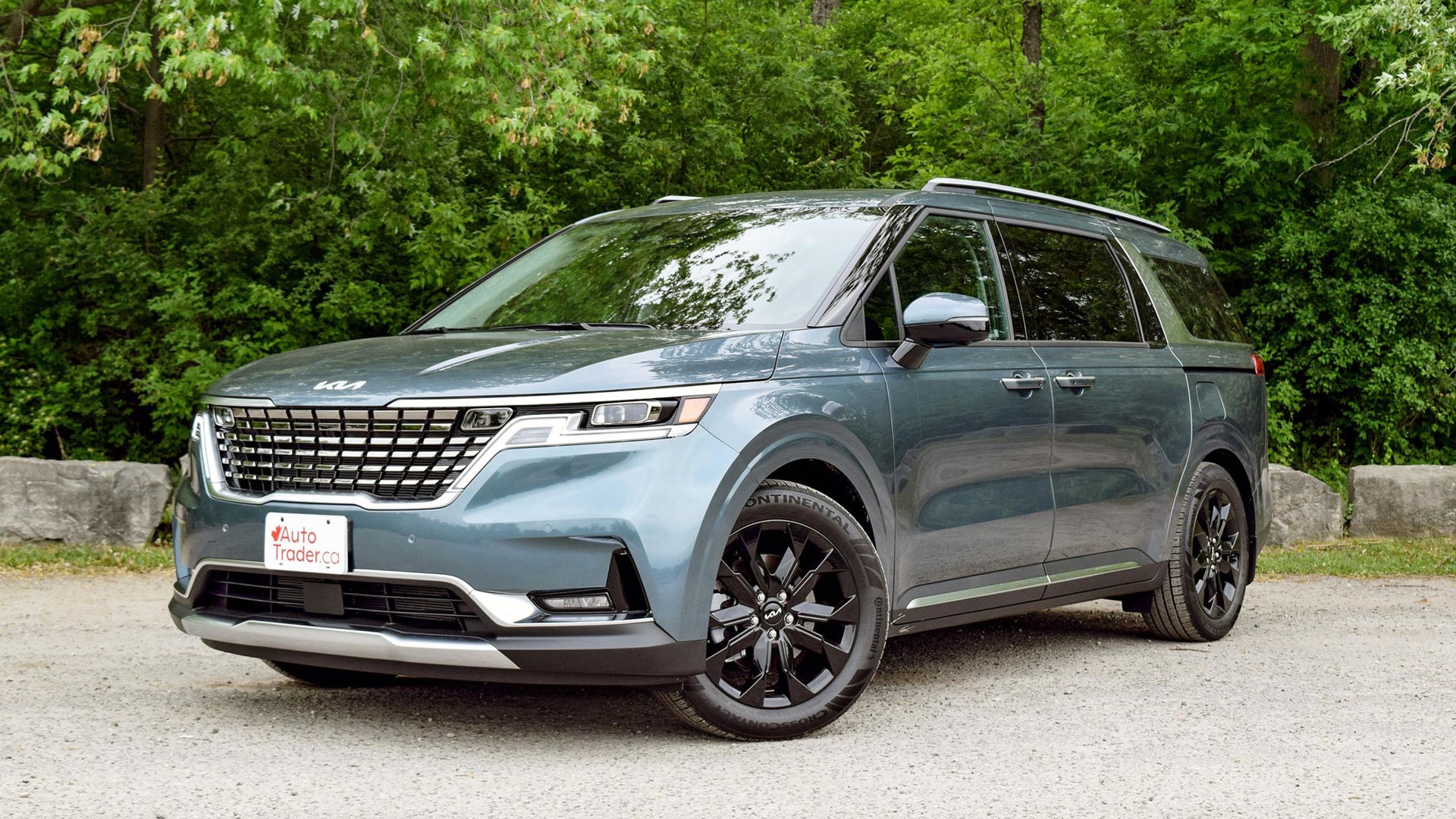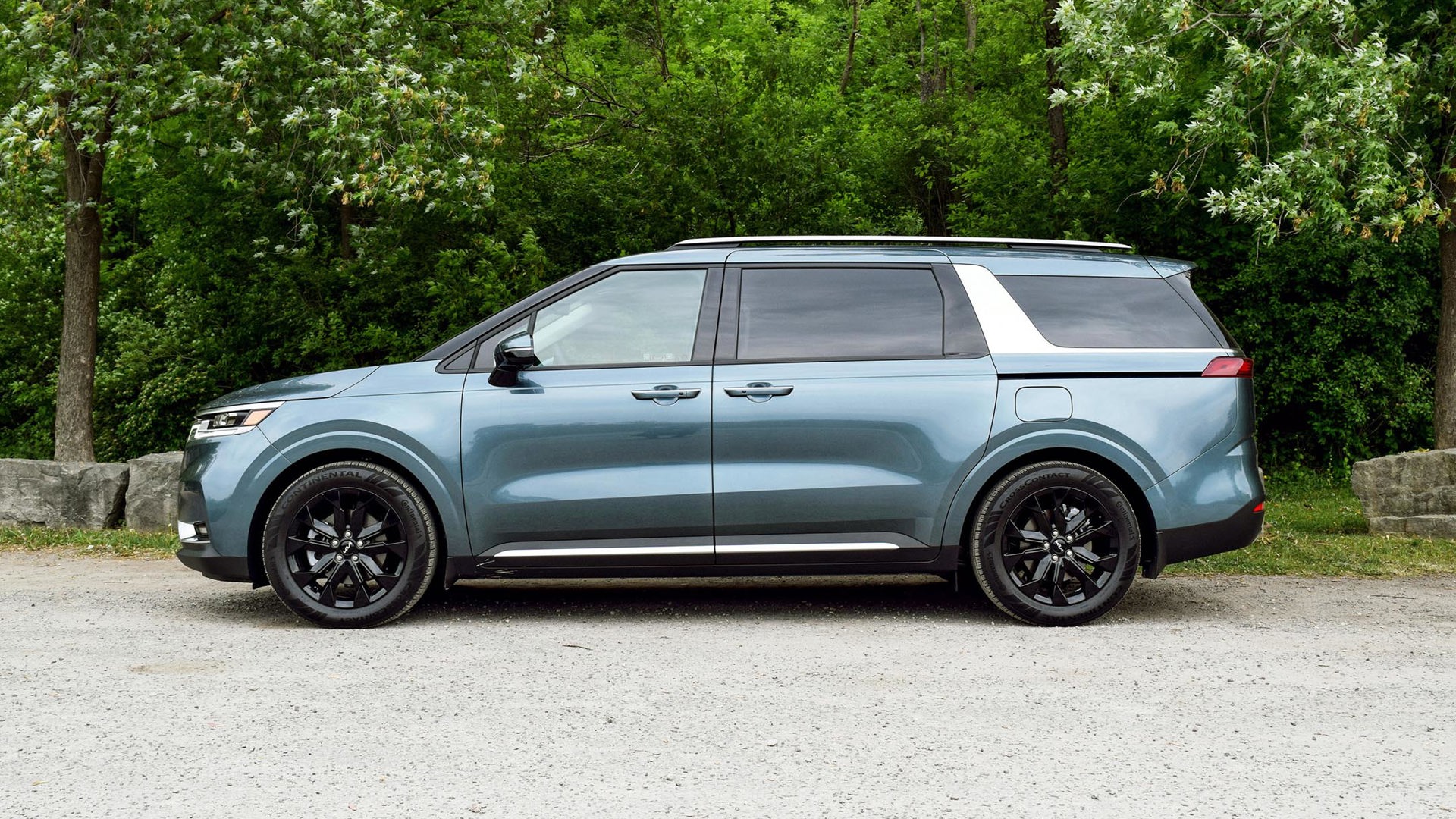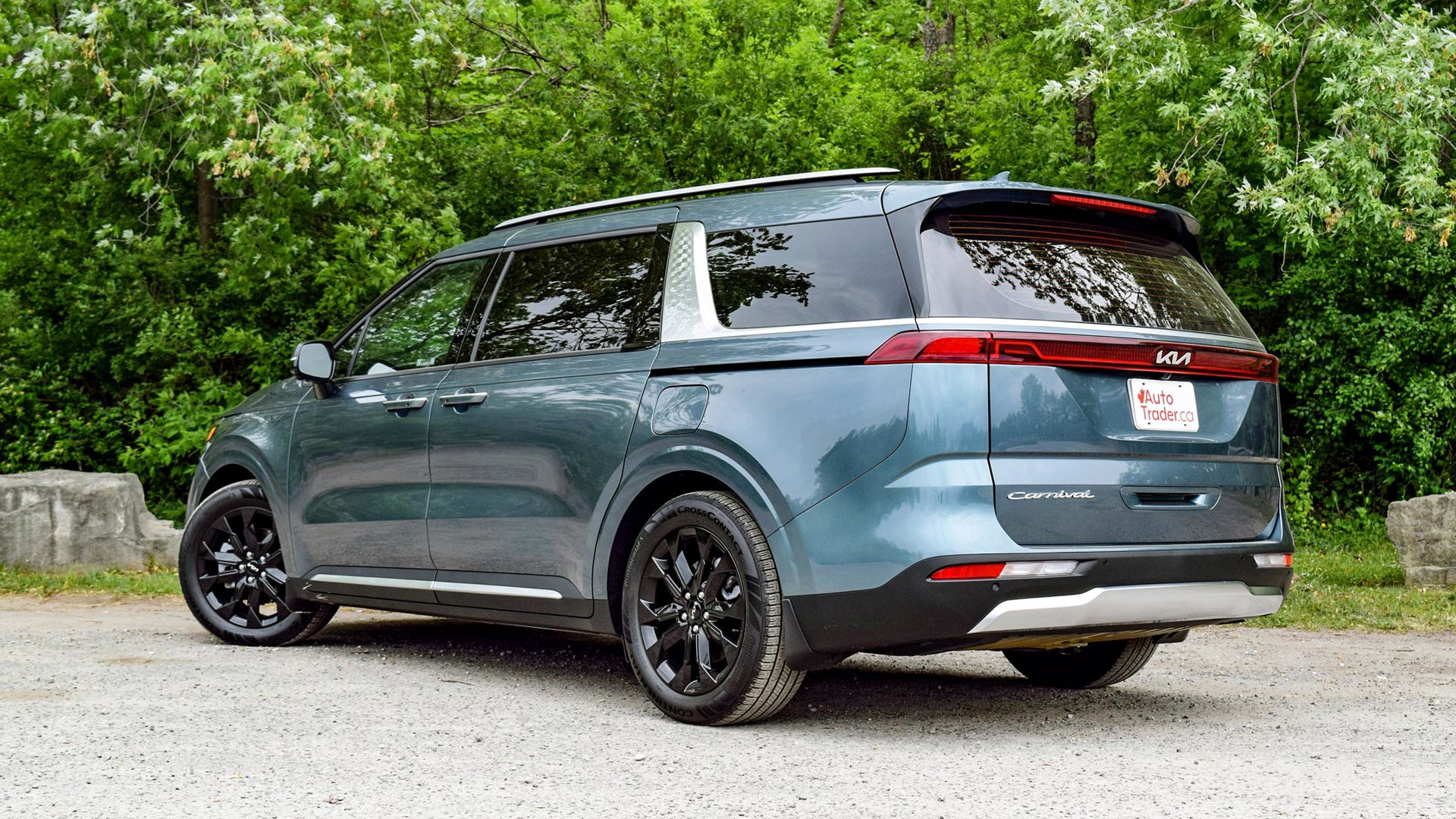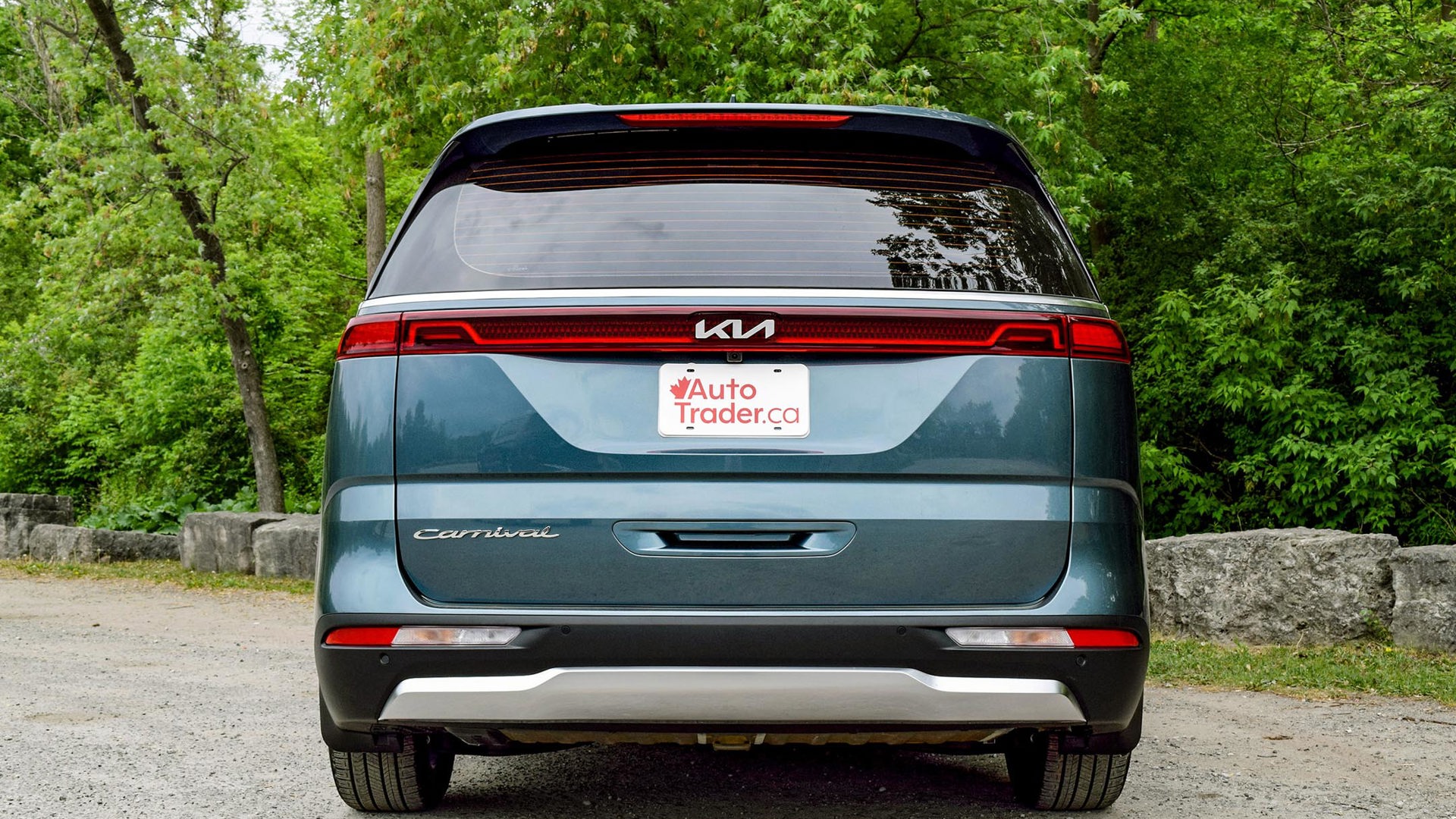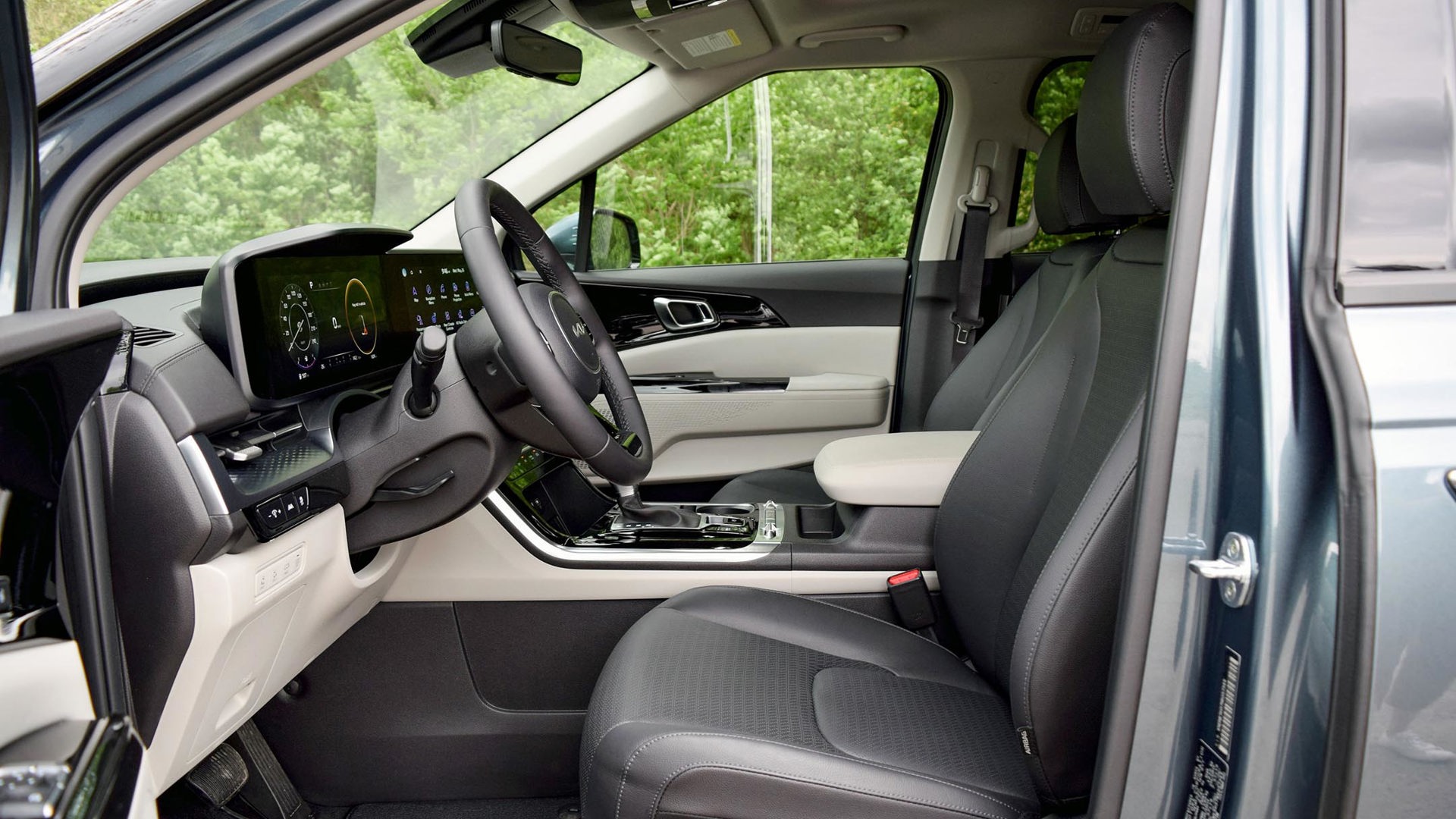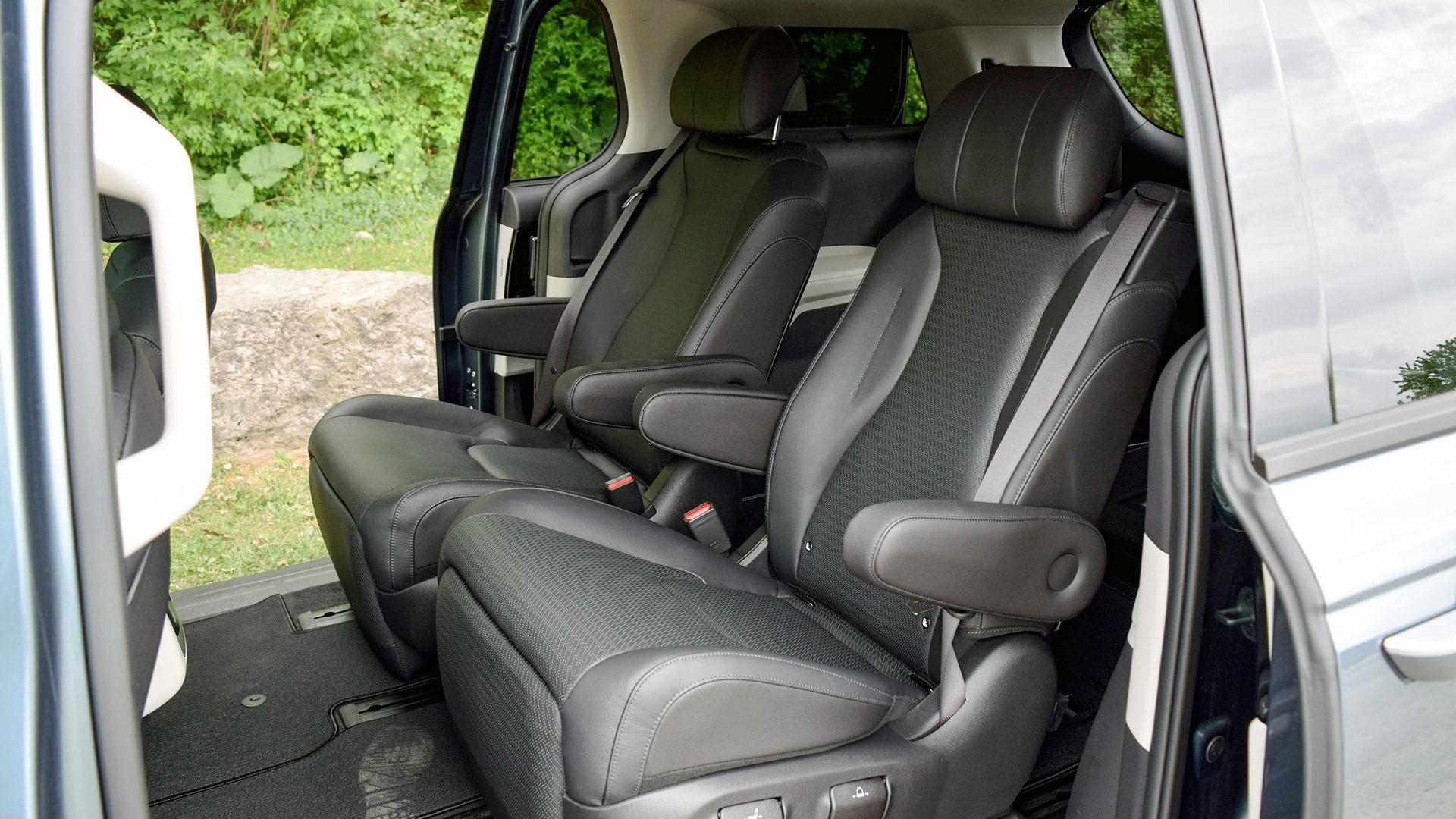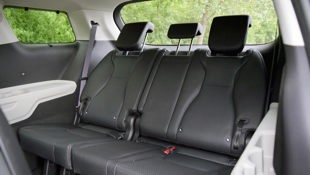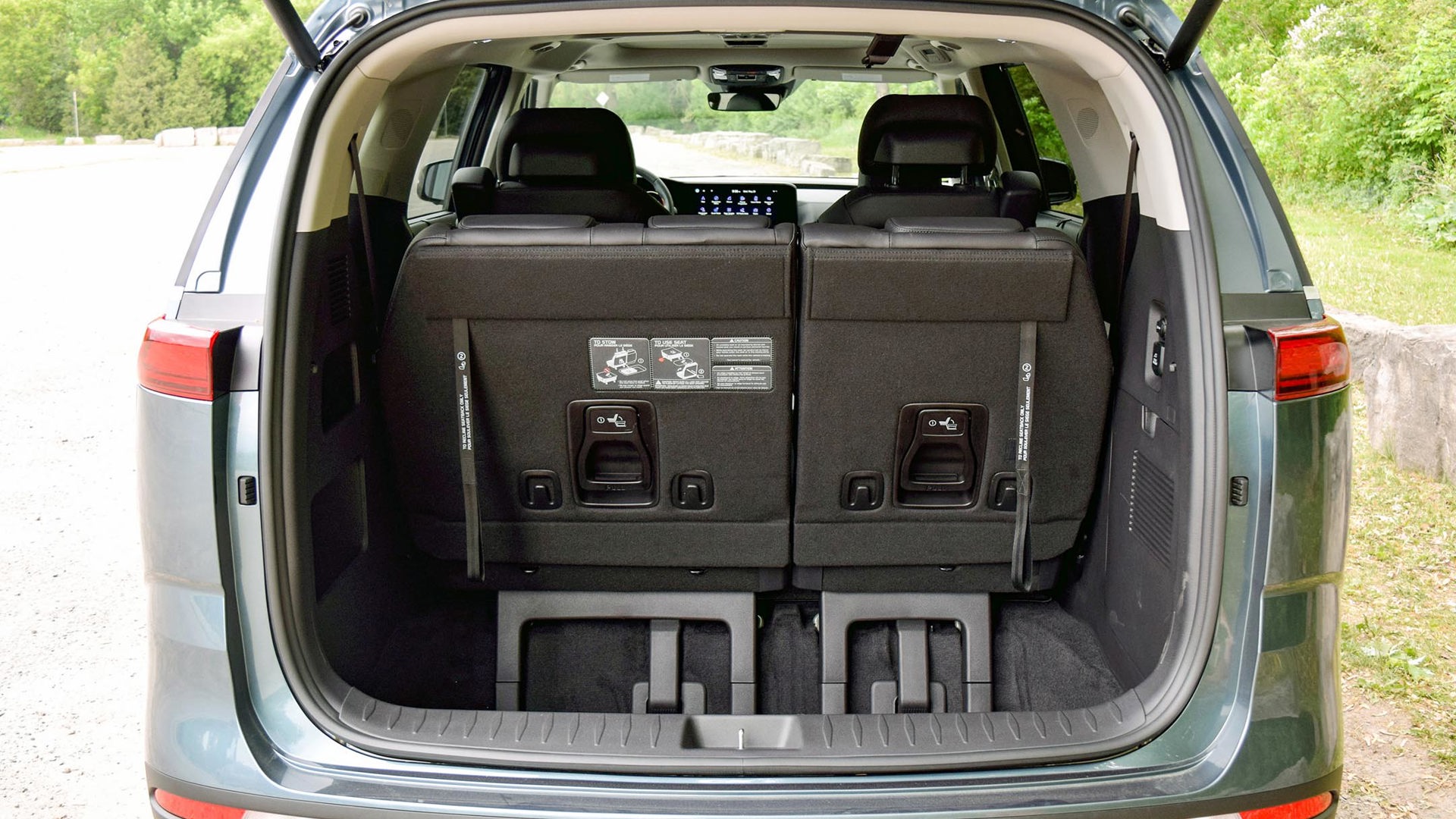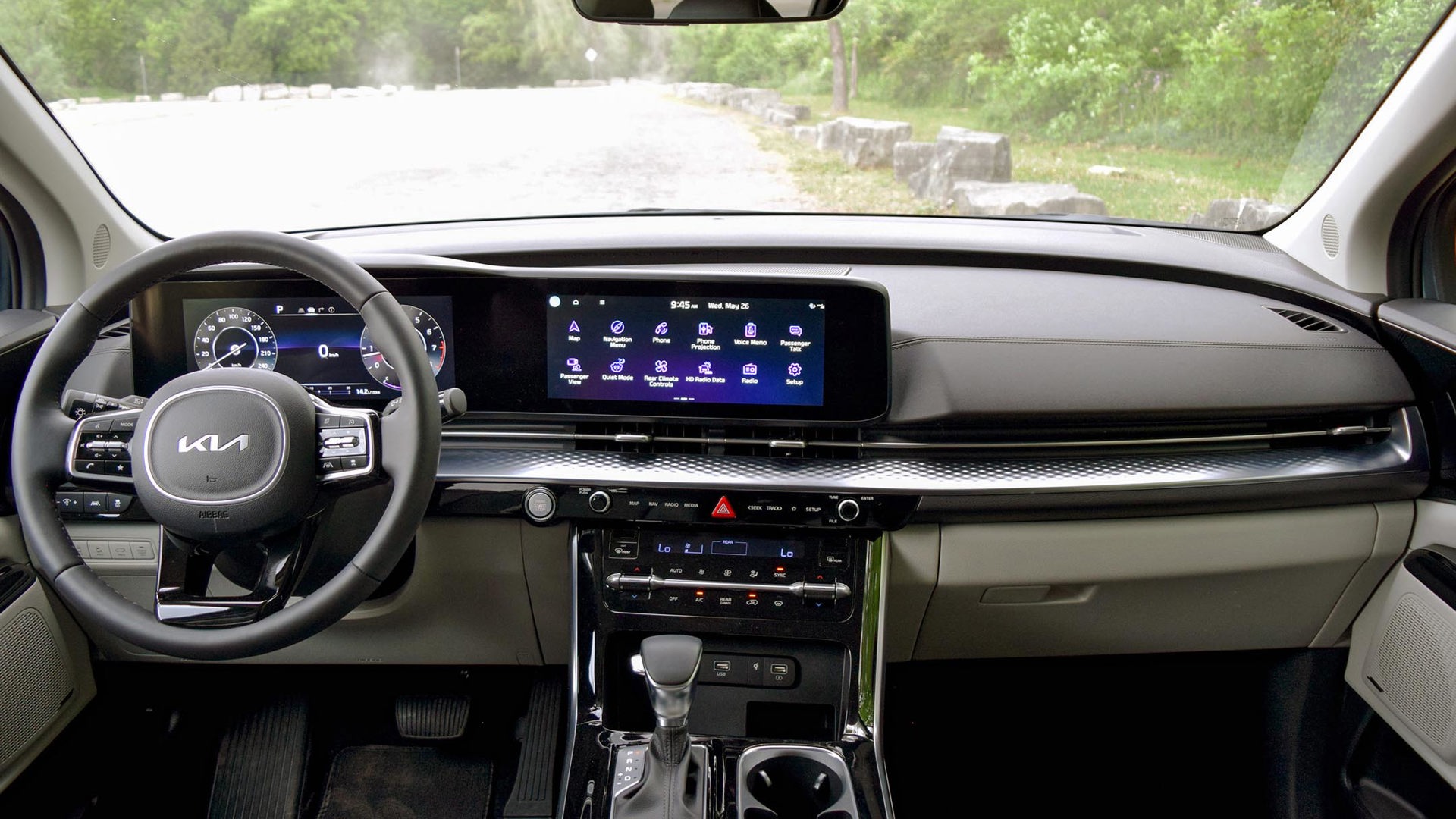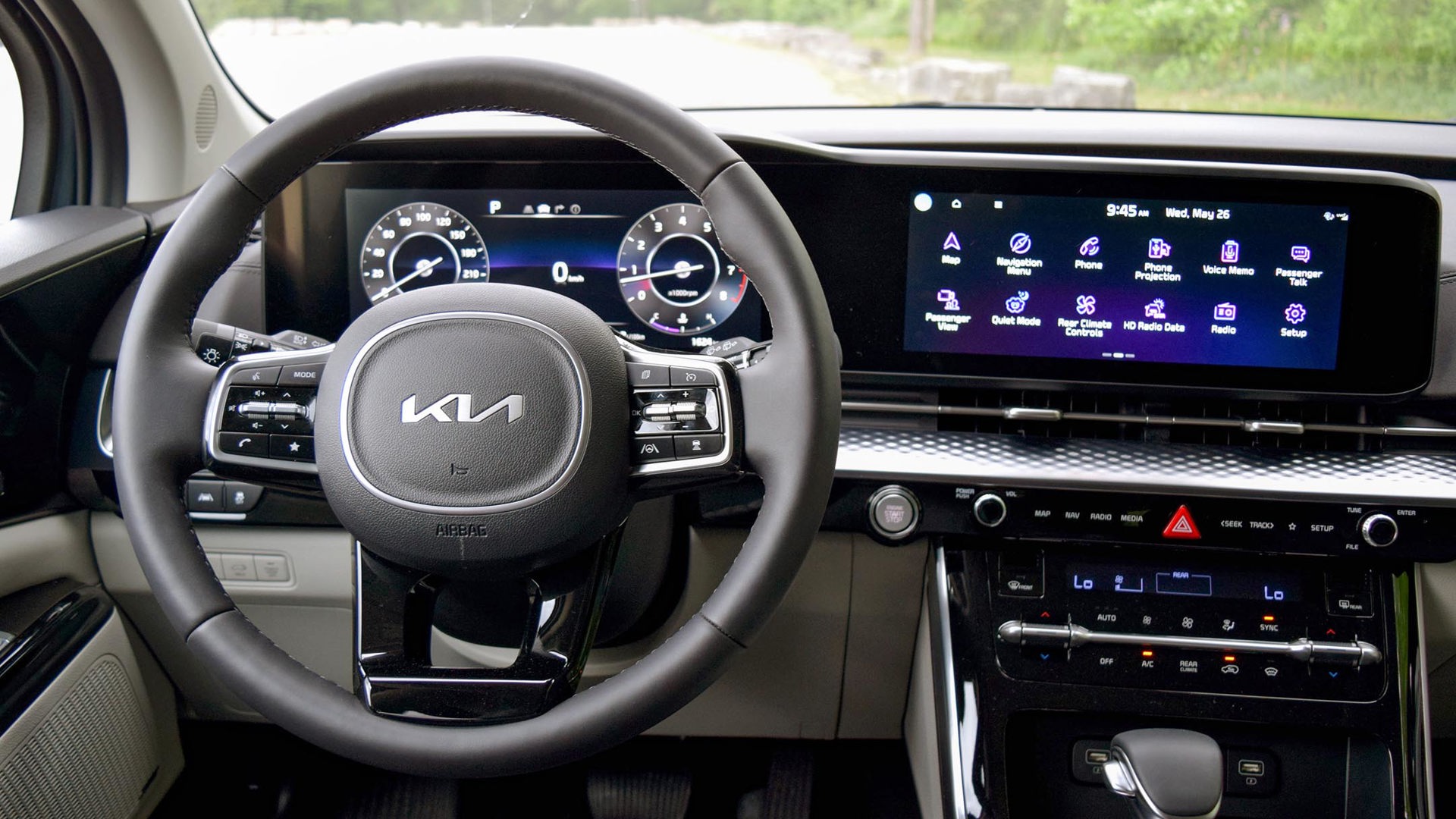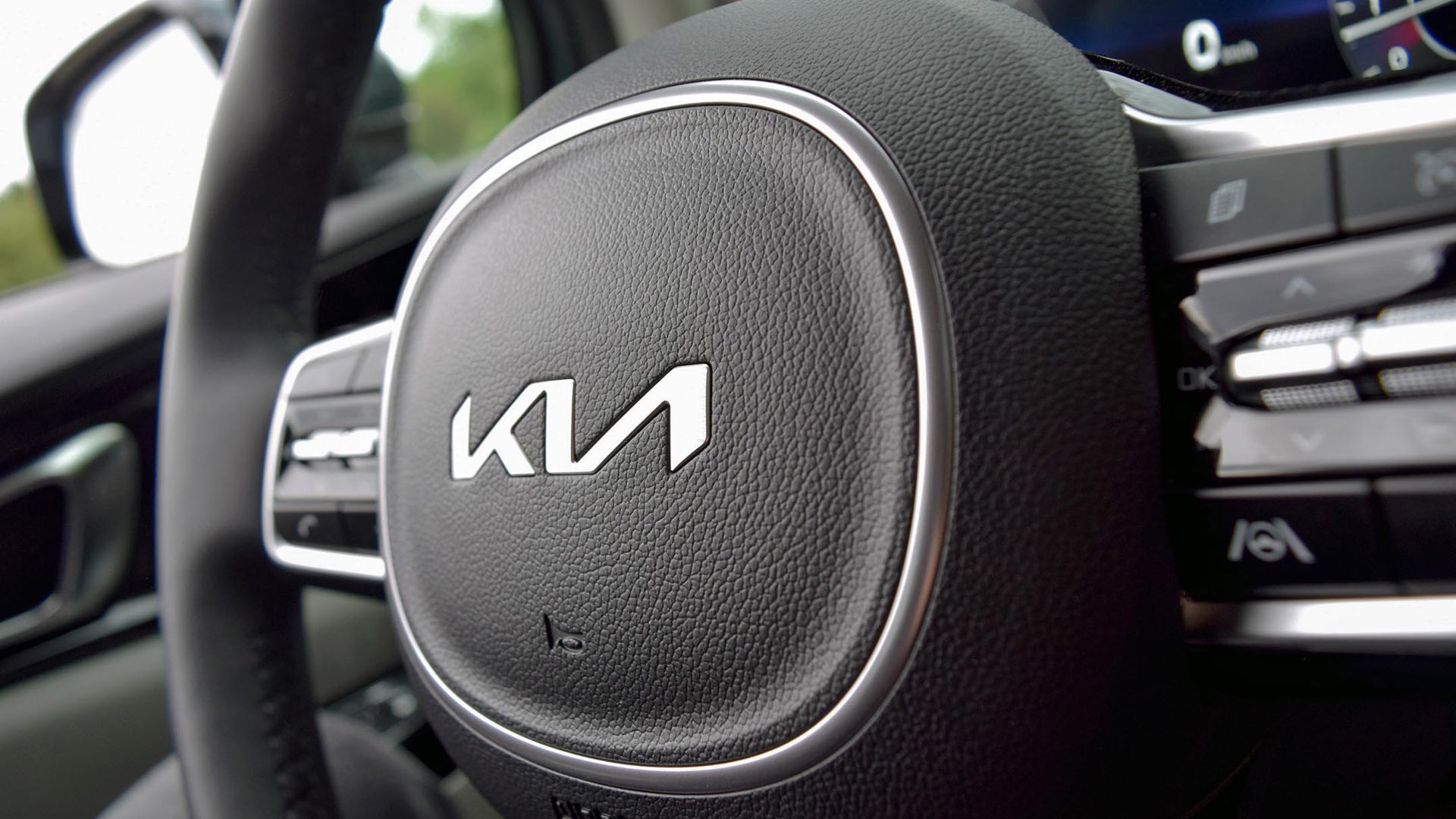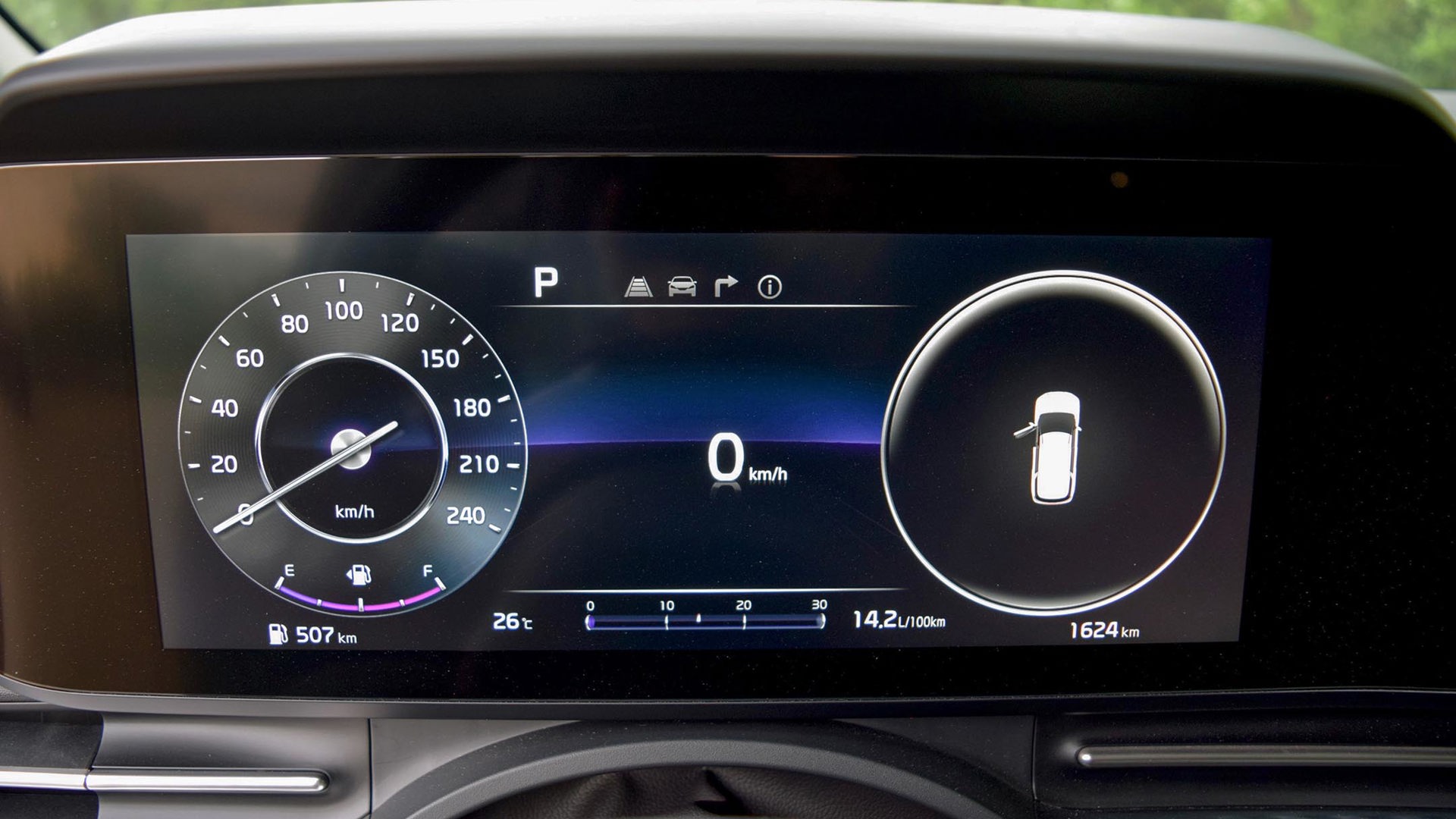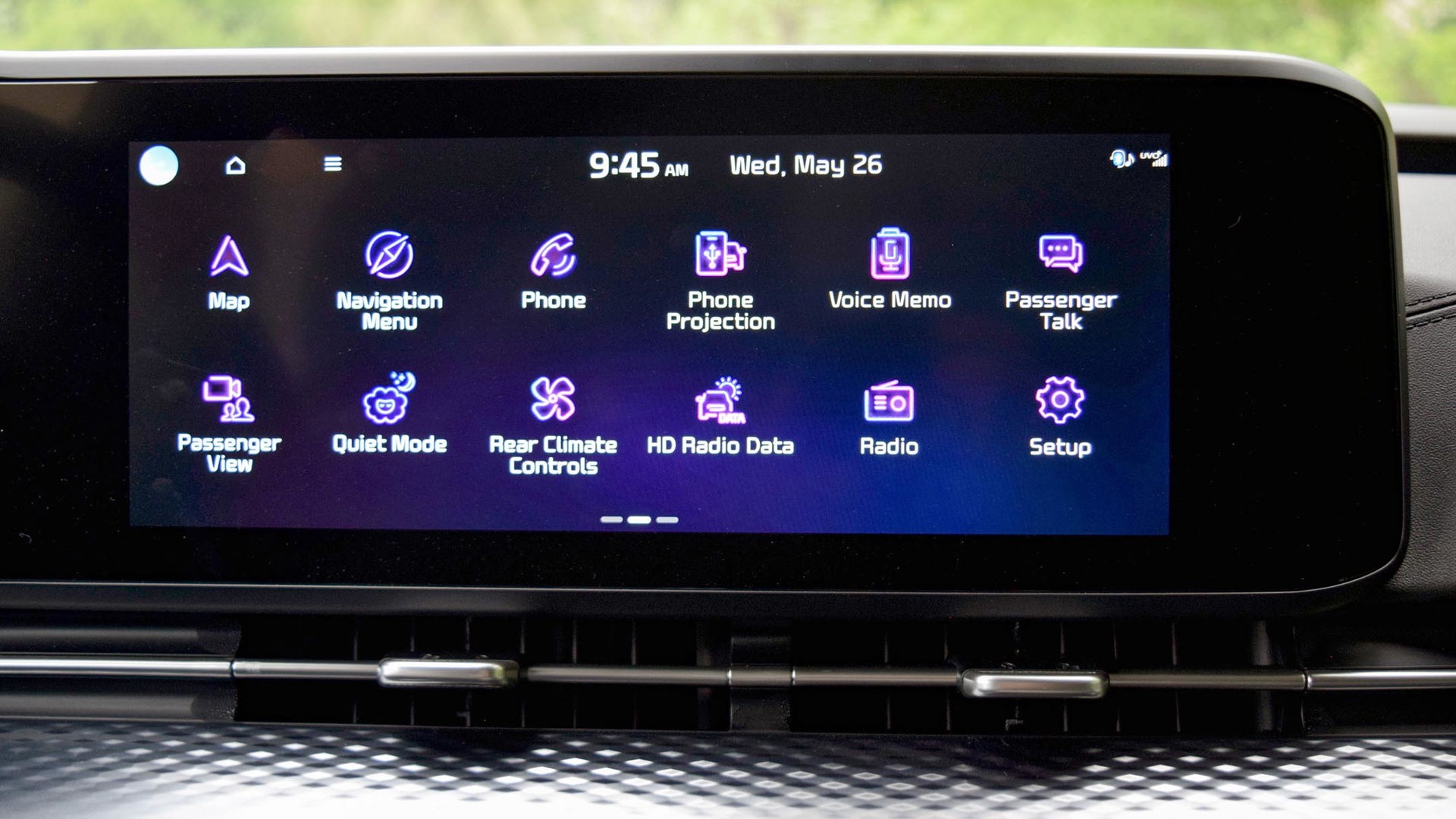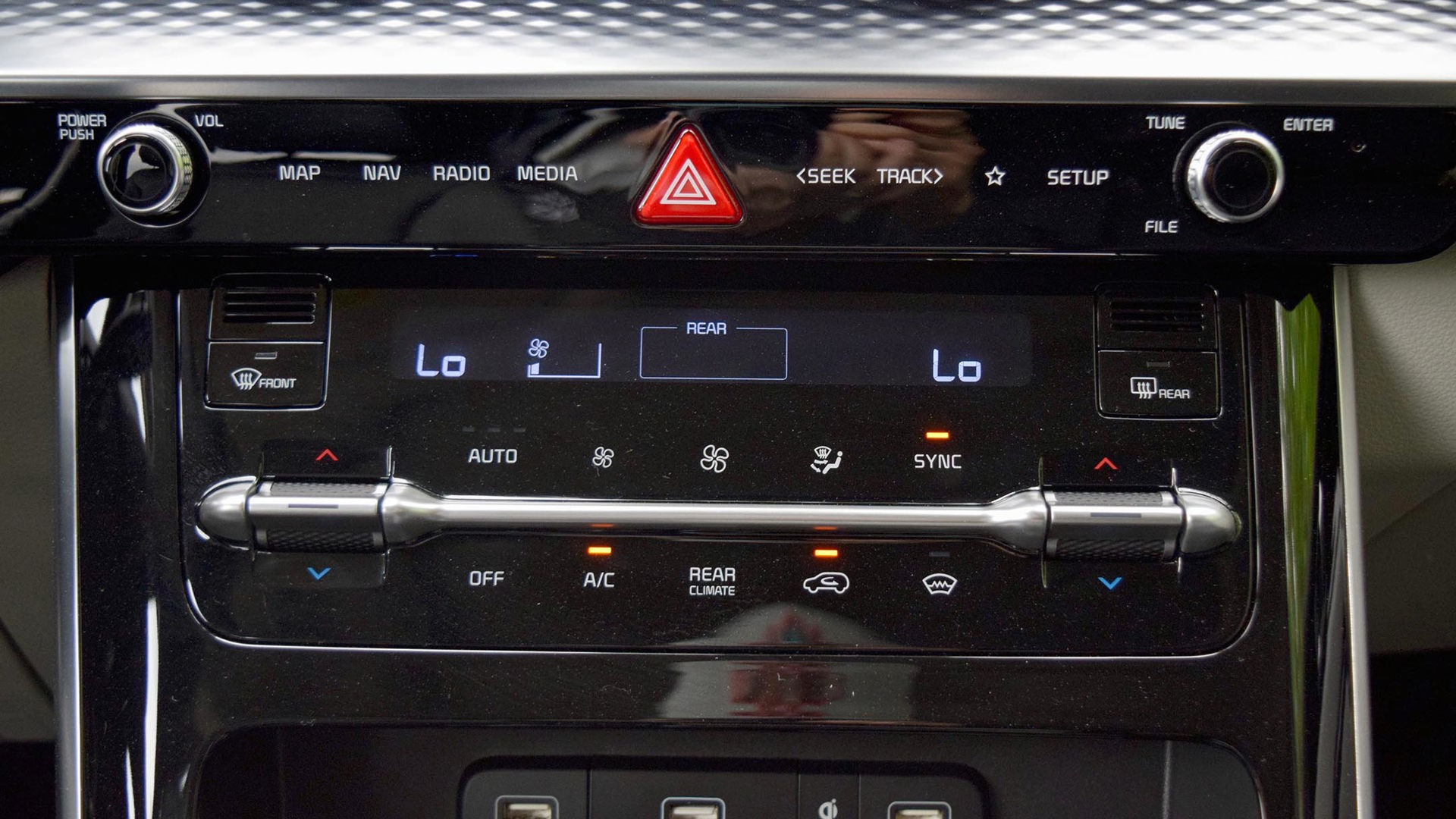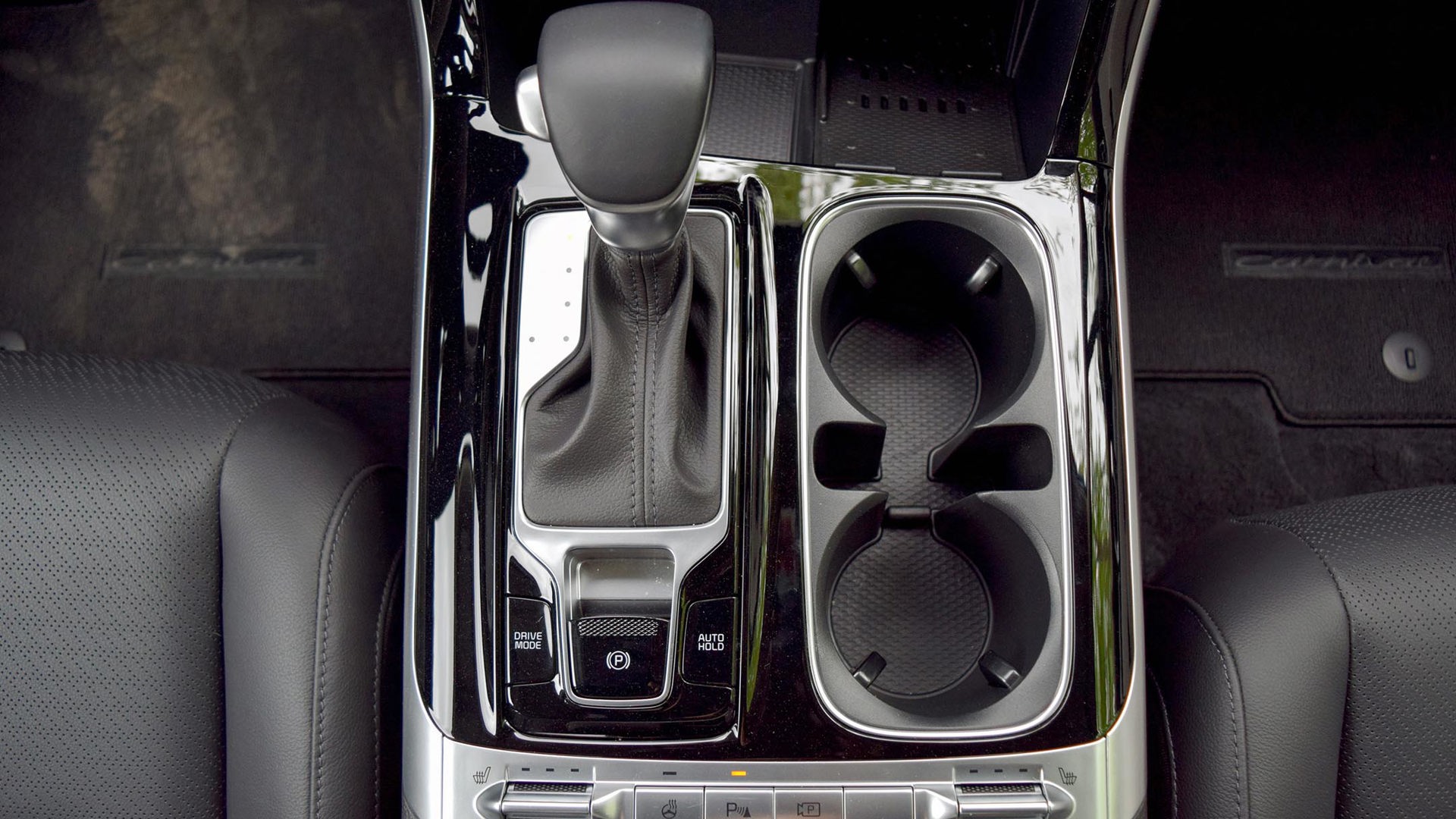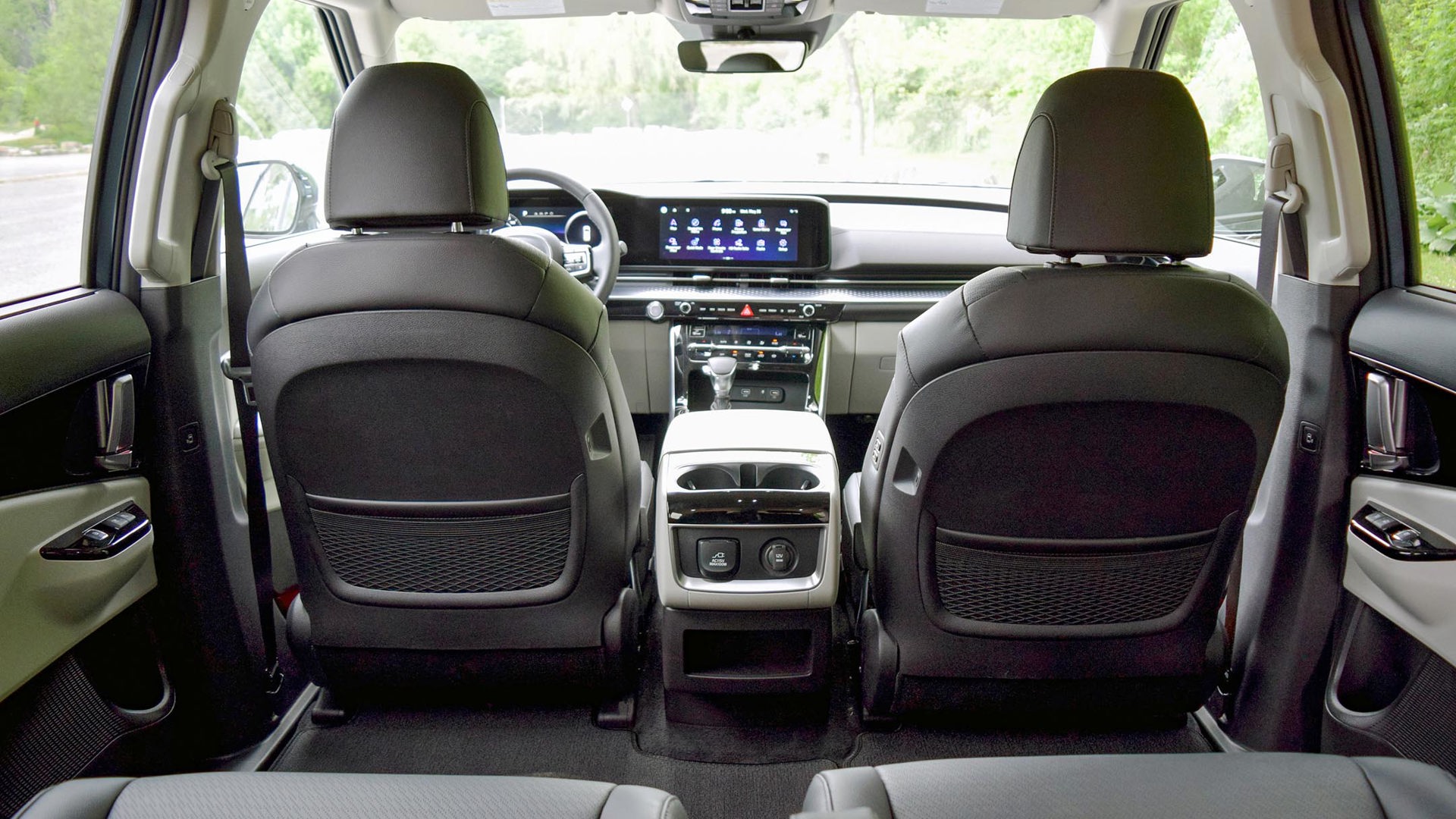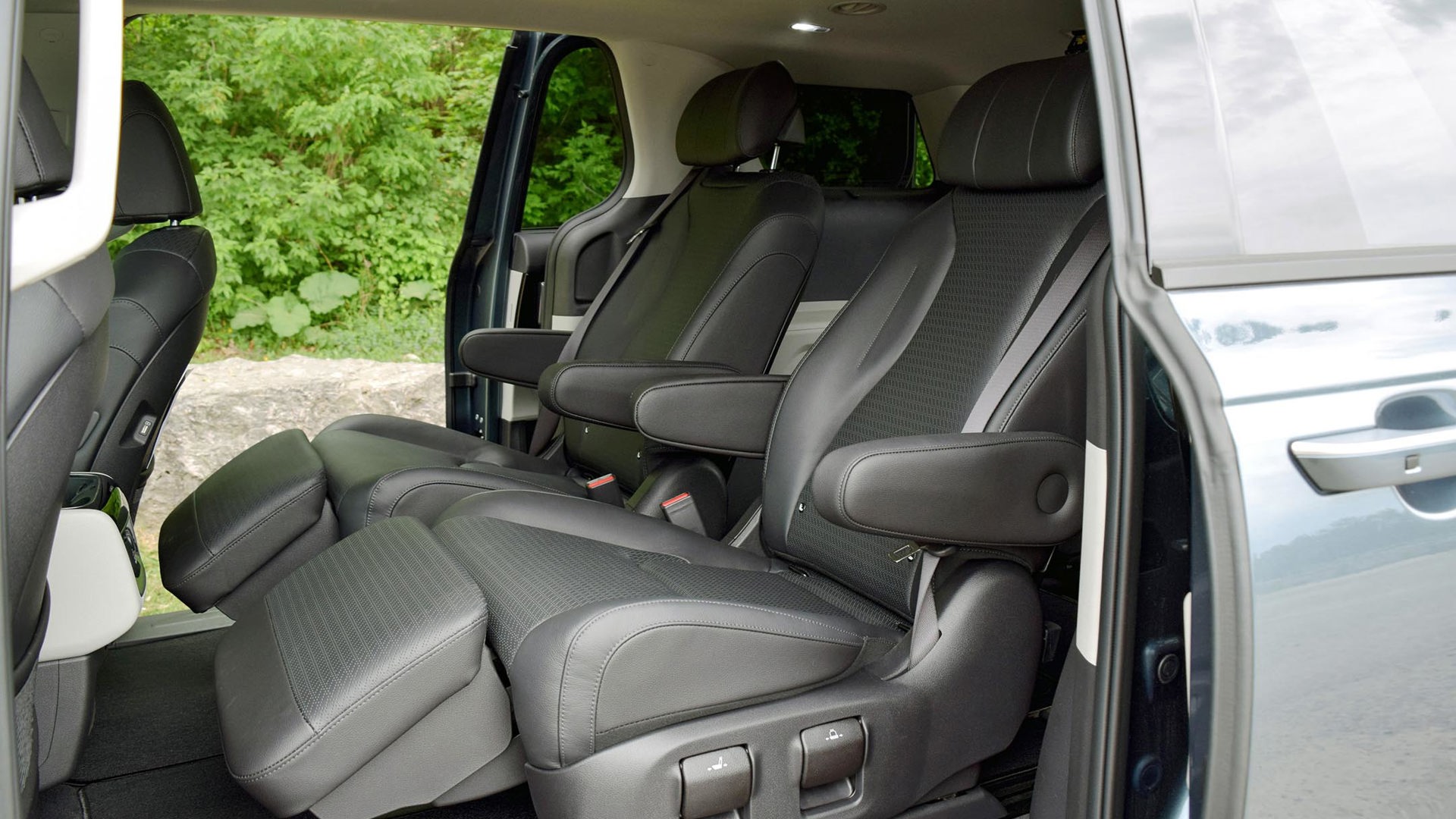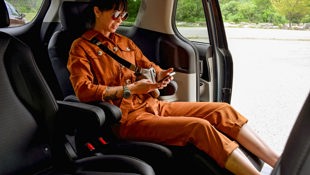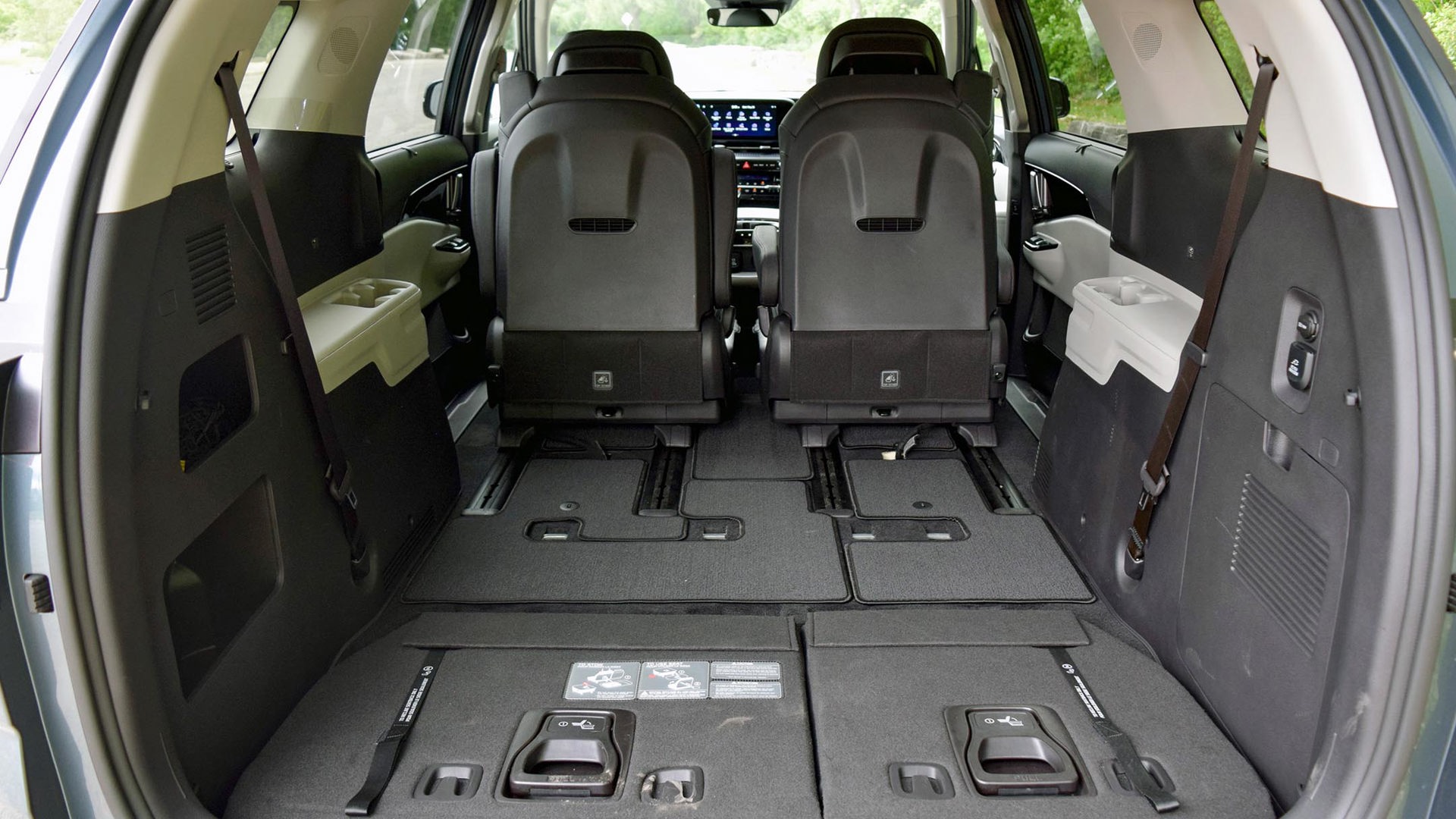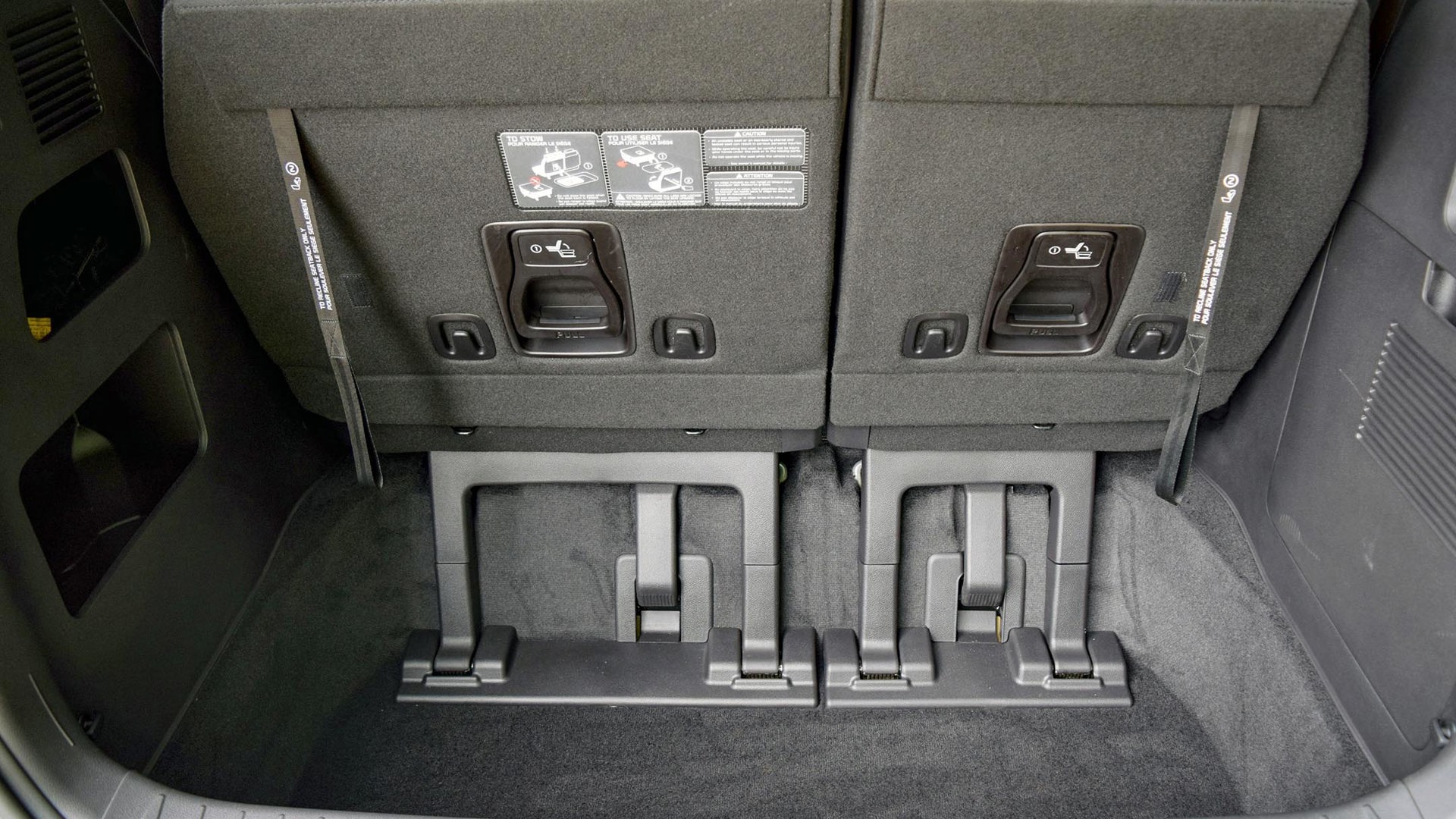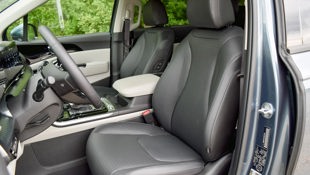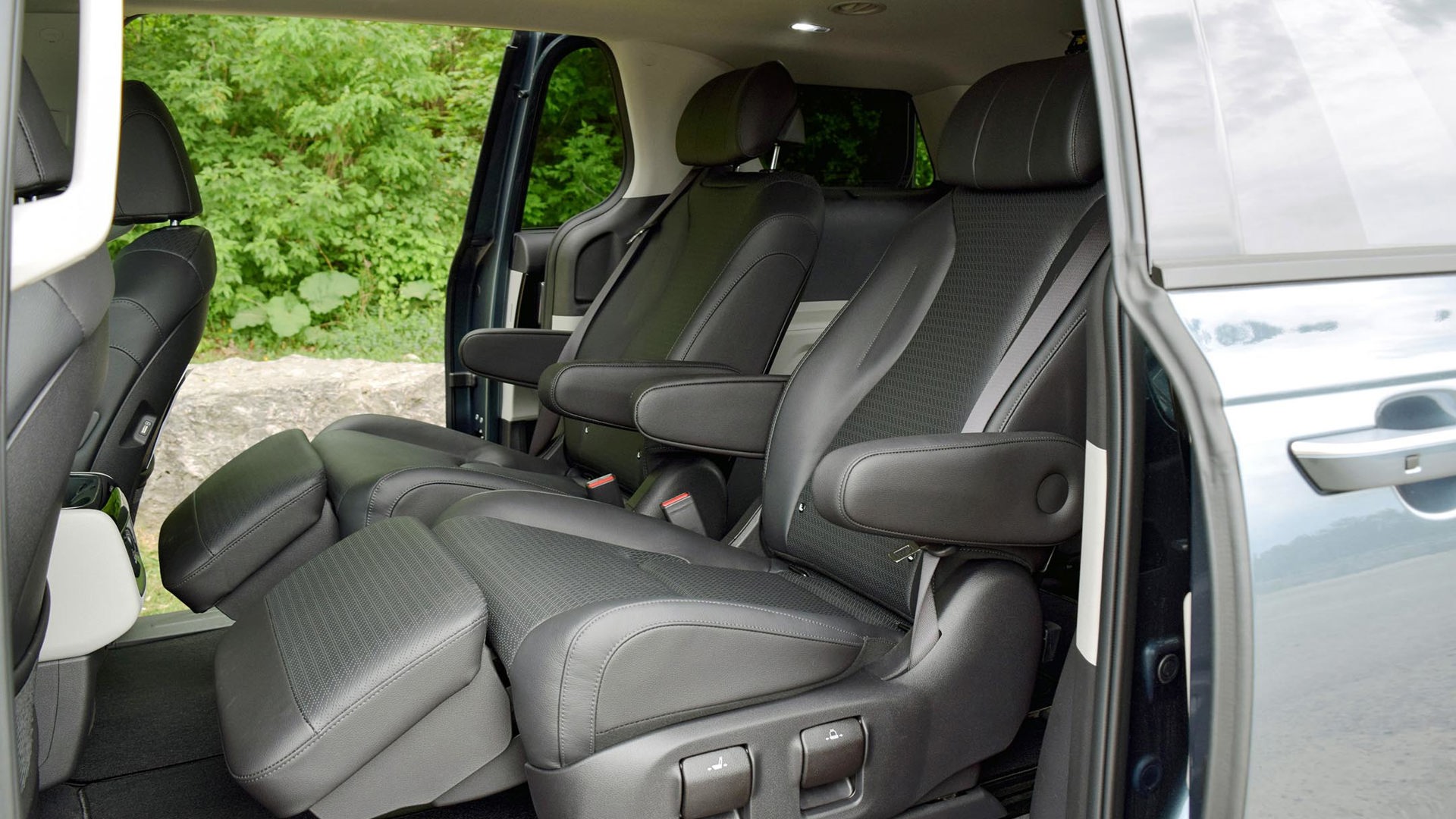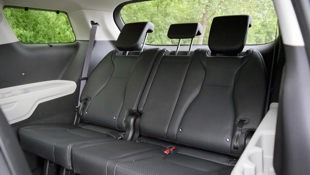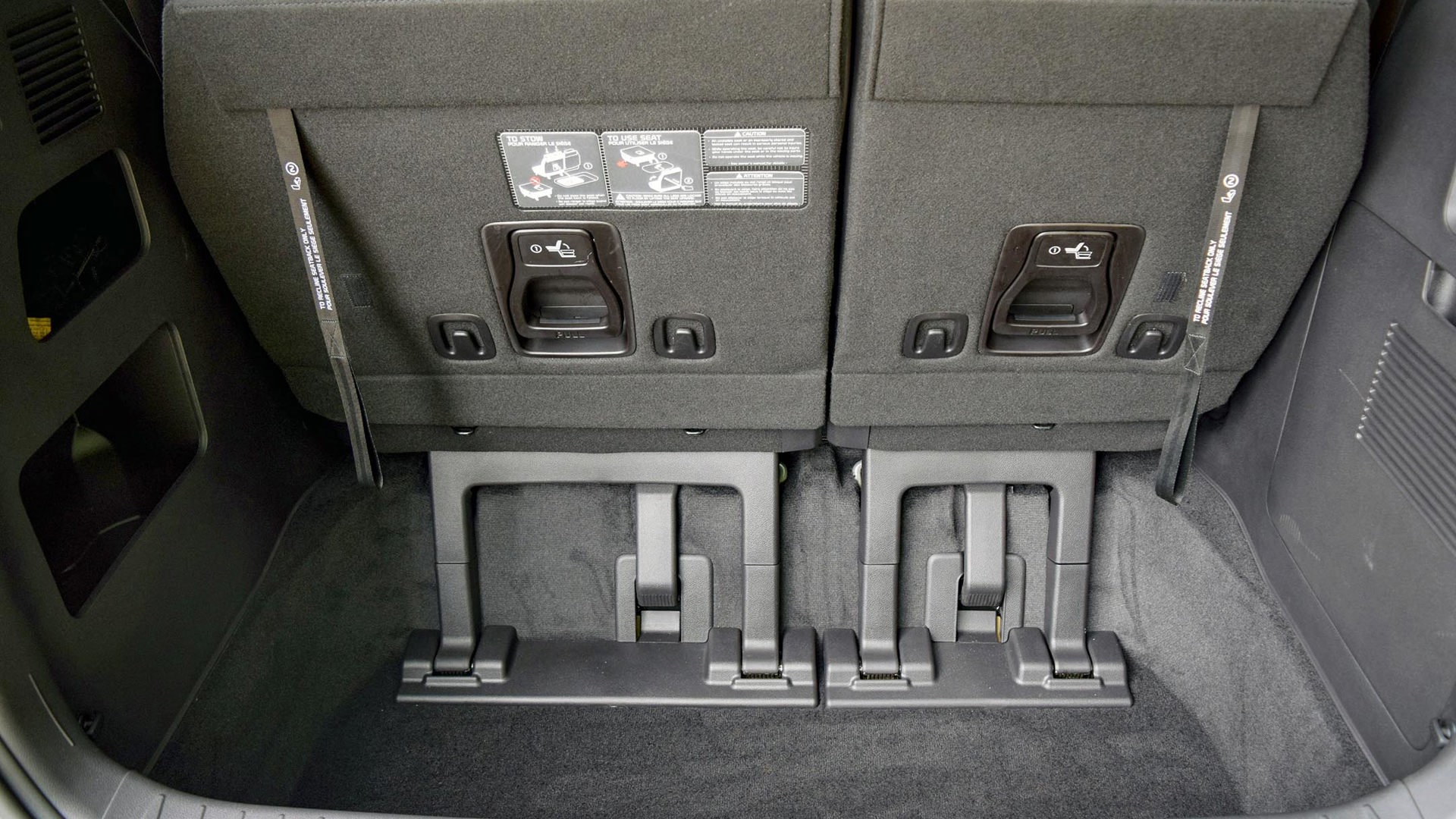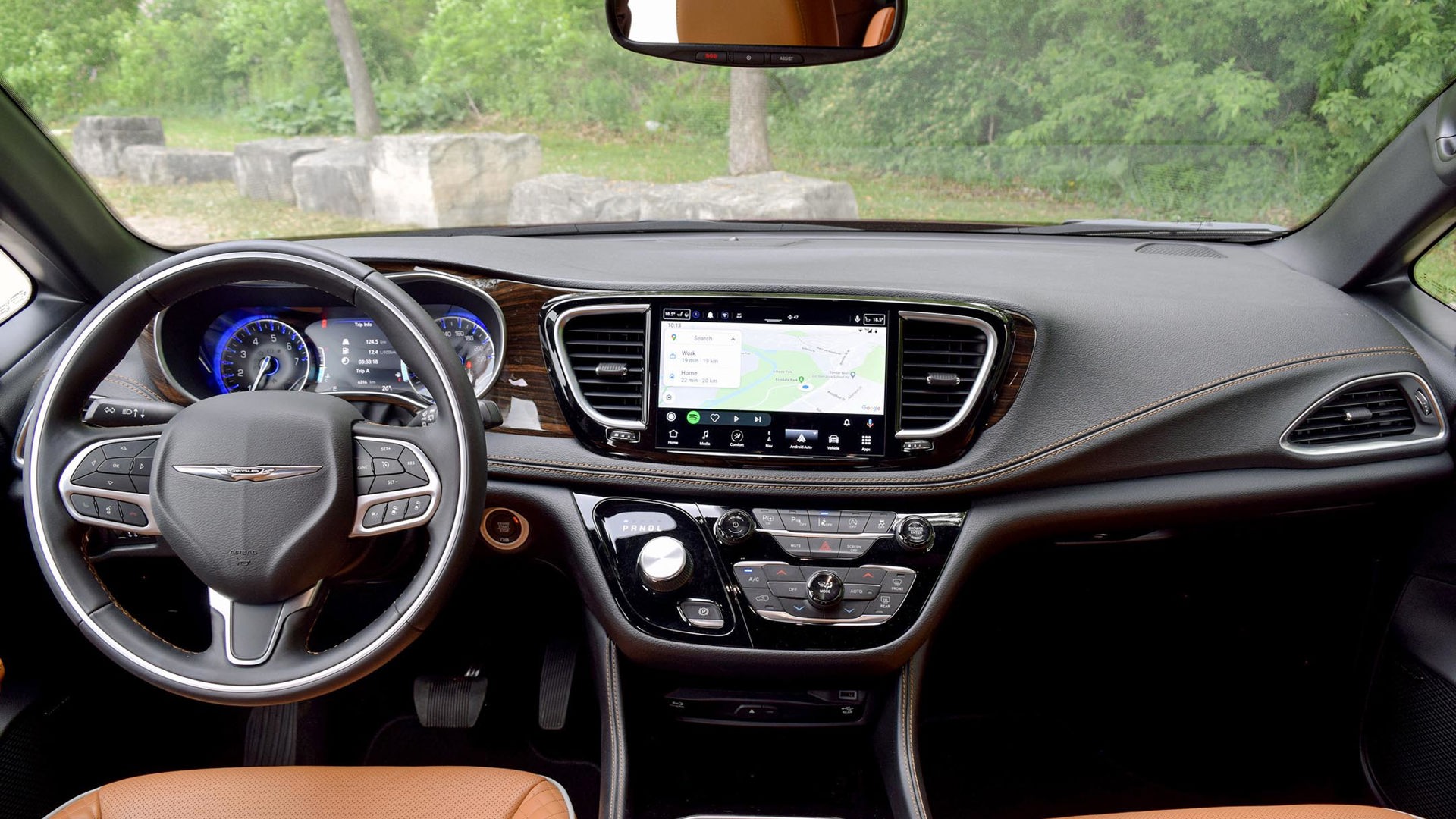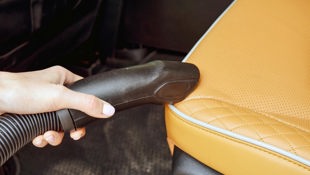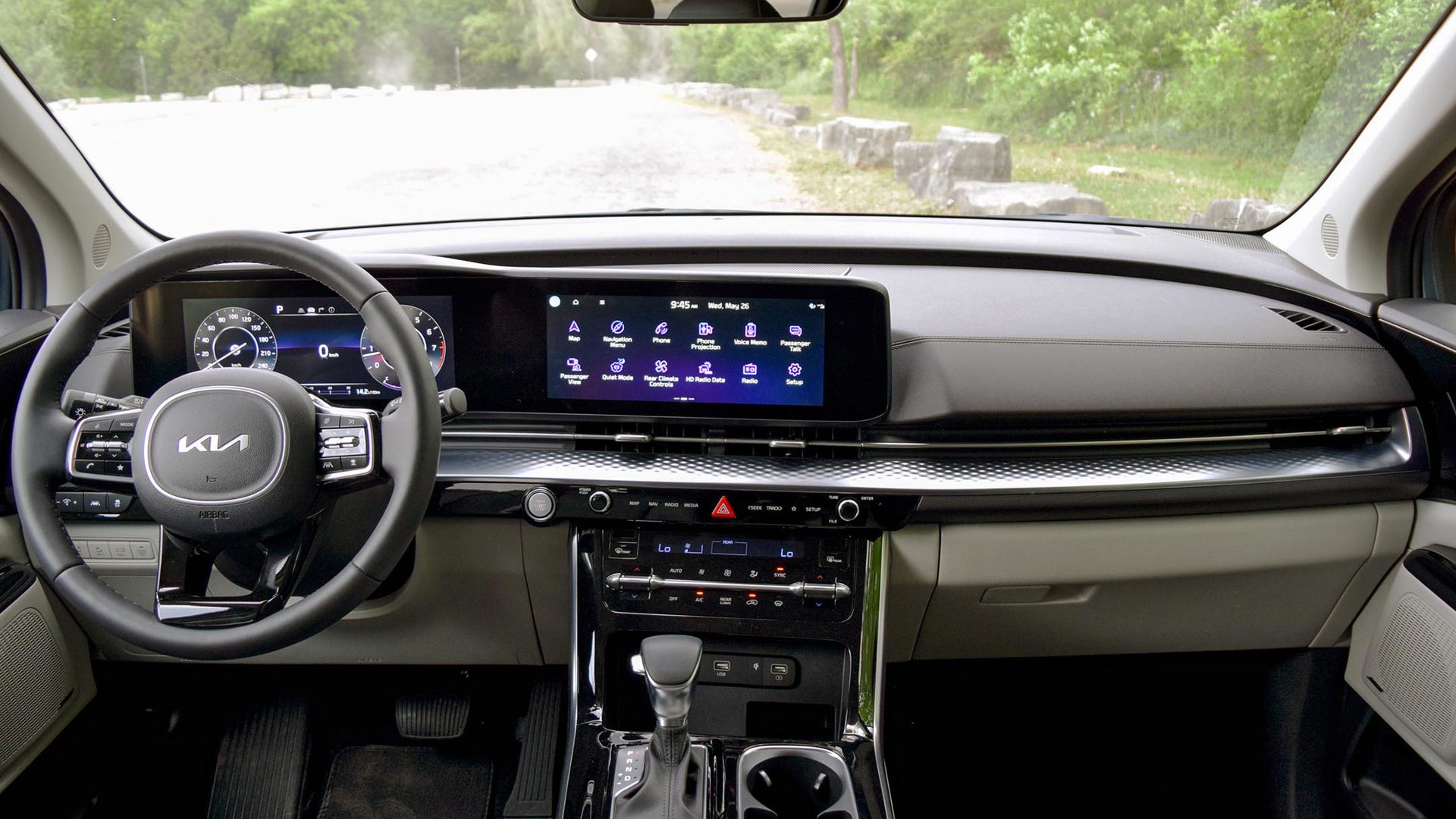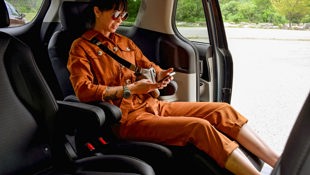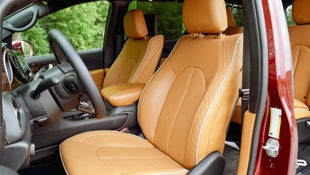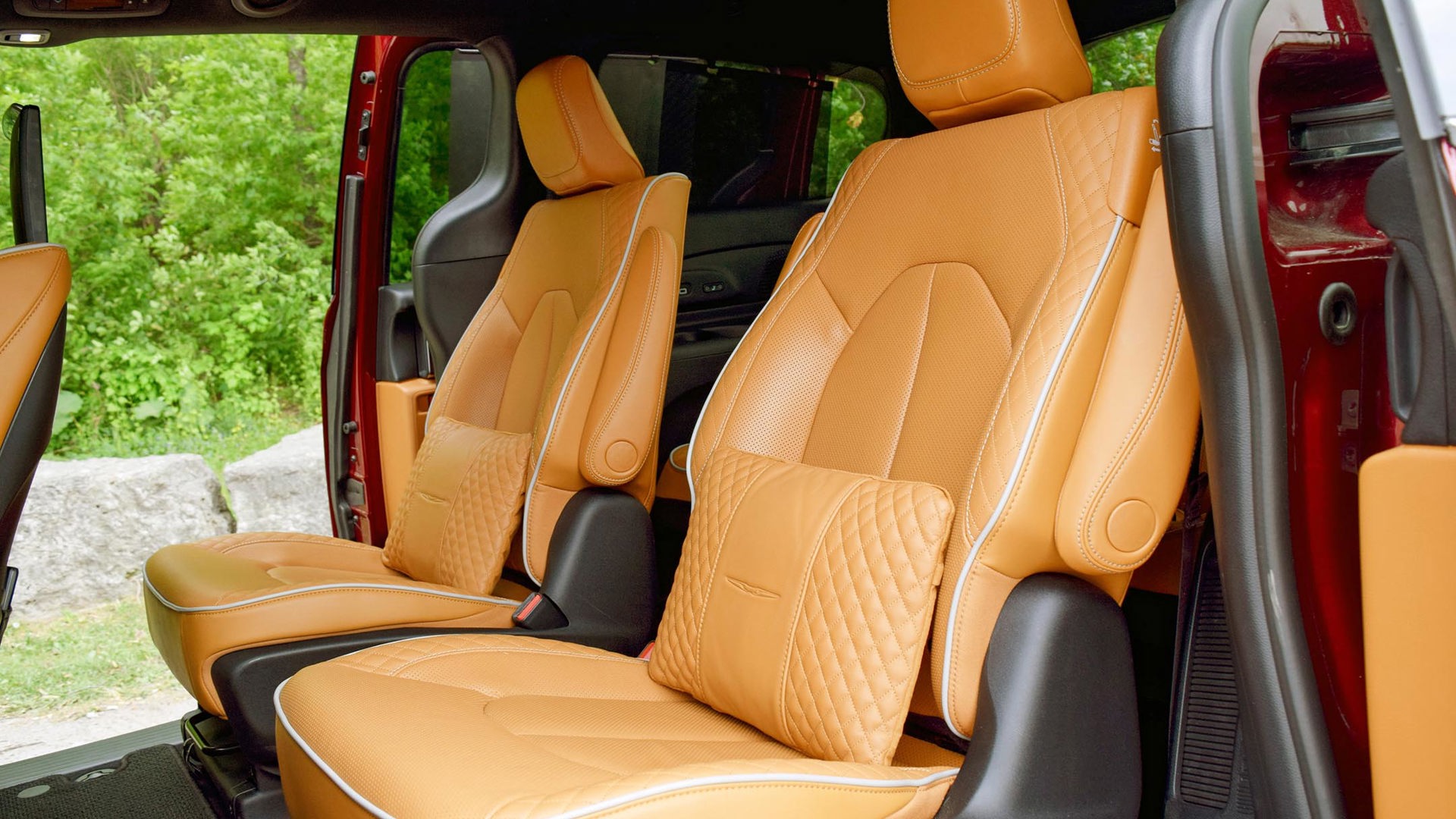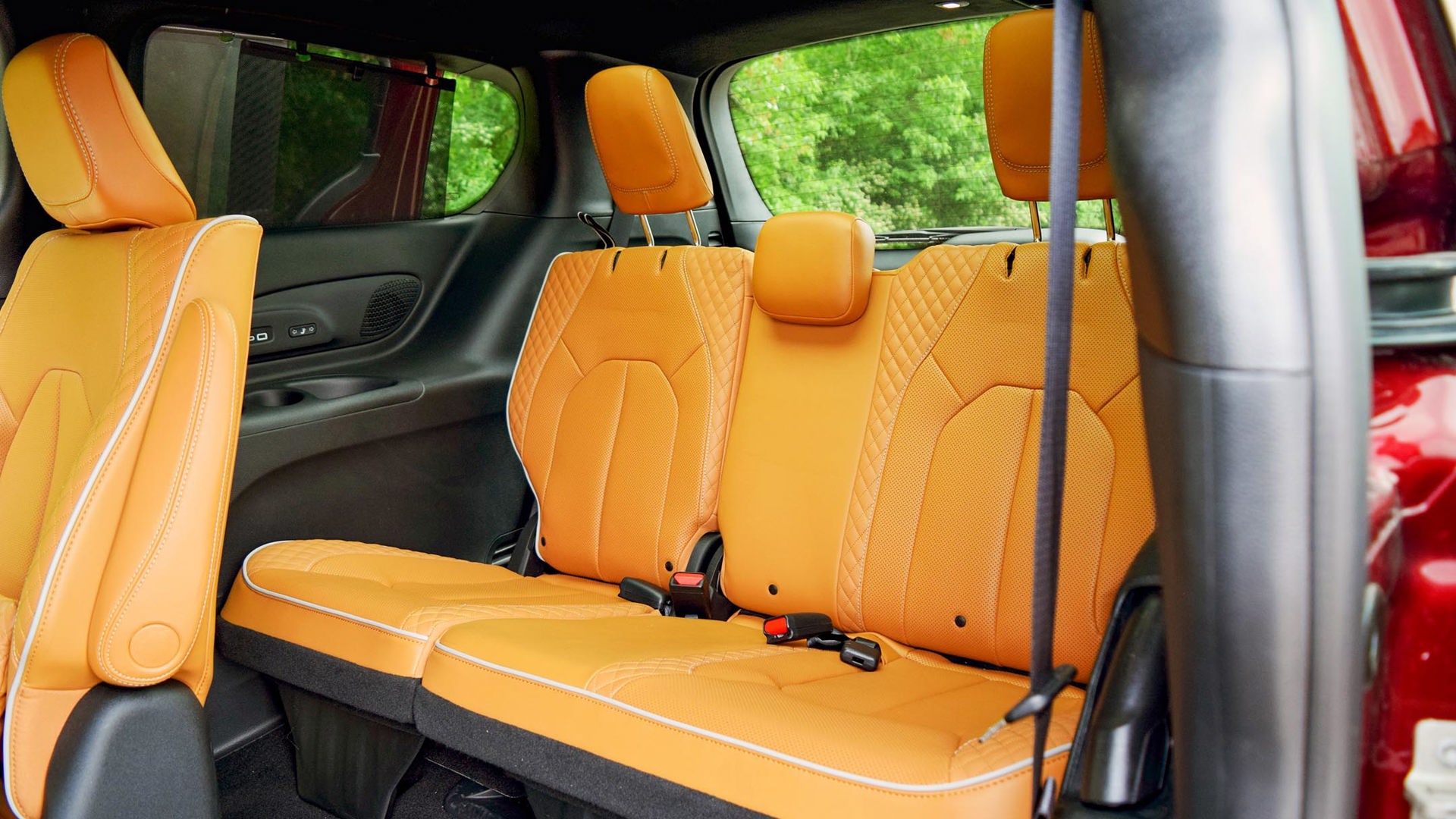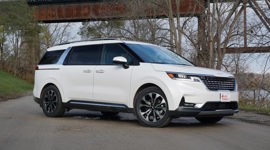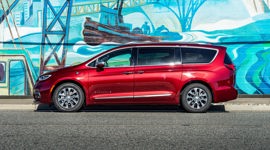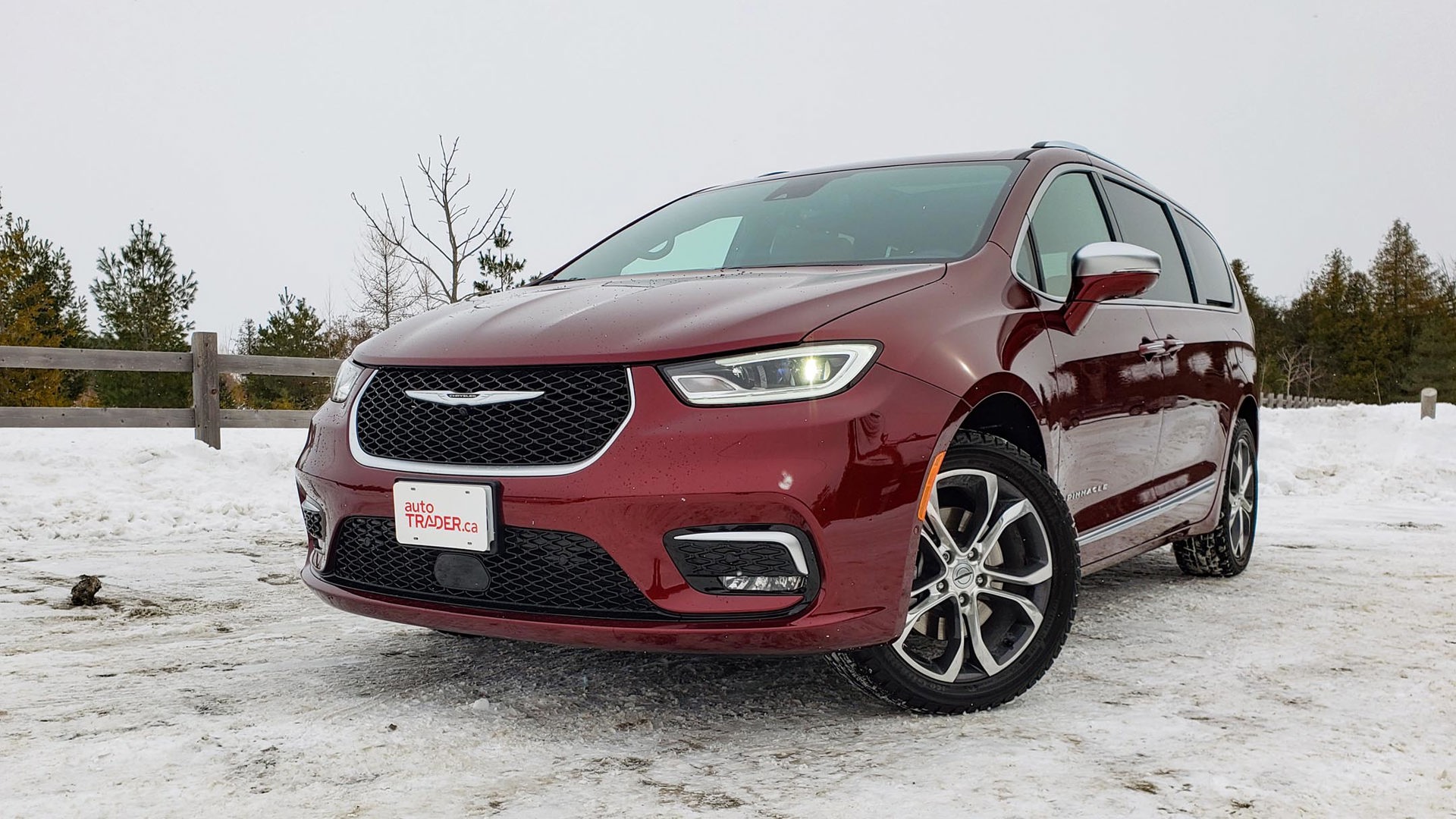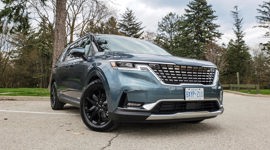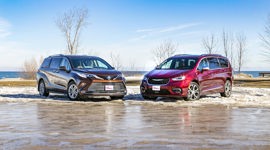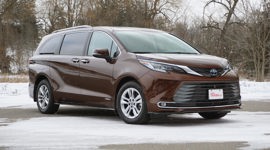Comparison Data
|
2021 Chrysler Pacifica Pinnacle AWD
|
2022 Kia Carnival SX
|
|---|---|
|
Engine Displacement
3.6L
|
3.5L
|
|
Engine Cylinders
V6
|
V6
|
|
Peak Horsepower
287 hp
|
290 hp
|
|
Peak Torque
262 lb-ft
|
262 lb-ft
|
|
Fuel Economy
14.1 / 9.4 / 12.0 L/100 km cty/hwy/cmb
|
12.0 / 8.9 / 10.6 L/100 km cty/hwy/cmb
|
|
Cargo Space
914 / 2,477 / 3,978 L behind 3rd/2nd/1st row
|
1,139 / 2,460 / 4,110 L behind 3rd/2nd/1st row
|
|
Base Price
$65,795
|
$48,595
|
|
A/C Tax
$100
|
$100
|
|
Destination Fee
$1,895
|
$1,850
|
|
Price as Tested
$68,785
|
$50,795
|
|
Optional Equipment
$995 – Velvet Red Peal Paint, $100; Trailer Tow Group, $895
|
$250 – Storm Blue Paint, $250
|
Minivans may be on life support, but the few automakers left in the segment are doing what they can to keep their entries fresh enough to compete with the vast array of three-row SUVs on the market.
The 2021 Chrysler Pacifica was on the receiving end of a few smart changes, including the introduction of the Pinnacle trim level that features an impressive interior. The Pacifica can also be had with all-wheel drive, providing extra confidence to drivers in a variety of weather conditions.
As a wholly reimagined offering, the 2022 Kia Carnival replaces the Sedona with more than a new name. Modern-looking and full of tech, the Carnival puts a unique emphasis on comfort above all else.
Styling
The 2021 Pacifica gets a revised look, with a different grille design that features a rounder shape than before – a style that’s been delegated to the more affordable Grand Caravan. The front end is framed by updated lighting, including standard LED fog- and headlights, which provide style and substance. The rear end is updated, too, with a new LED light bar that runs the entire width of the vehicle. Best described as a one-box shape, the Pacifica is unique-looking on the road, even if it lacks much contouring.
That changes when you open the doors and get settled into the interior. This top-trim model features a bright caramel leather upholstery with quilted stitching. The high-quality look is extended to all three rows, and the cabin is full of clever storage areas that are both hidden and easily accessible. The Pinnacle also gets a pair of throw pillows, though kids may end up using them as weapons to solve disagreements or block their antics from the overhead camera.
The 2022 Carnival has a more defined two-box design, with styling that’s intentionally more SUV than van. Blacked-out pillars at the front and rear of the vehicle provide a floating roofline look, framed with chrome strips beneath and behind the sliding doors, and a similar finish on the roof rails. The accents are a bit much, but the Carnival delivers something a bit beyond the usual minivan experience. A large grille with flashy inserts is certainly eye-catching, while the rear-end design also features a lighting element that spans the width of the vehicle.
Inside, the Carnival doesn’t make that same first impression as the Pacifica, lacking that punch the Chrysler packs with those gorgeous leather seats. The Carnival’s leather thrones are still nice, but this Kia impresses more with its dash and console layout. Though it looks more like a traditional crossover rather than the open-ended space found in the Pacifica, the Carnival has high-quality trim and controls, and attractive details that aren’t commonly found in this segment. It is, however, lacking the storage cubbies found in the Chrysler.
Pacifica: 7.5/10; Carnival: 8/10
Safety
While safety is a pillar for so many family vehicles, it comes to the forefront in these minivans. The Pacifica comes with a ton of standard safety features including forward collision warning and automatic emergency braking with pedestrian detection, blind-spot monitoring and rear cross-traffic alert, rear parking sensors, adaptive cruise control that works in stop-and-go traffic, and lane-departure warning. However, even with eight airbags, and five child-seat anchor positions, and “Good” crash-worthiness scores by the Insurance Institute for Highway Safety (IIHS), it hasn’t been awarded any safety awards by the institution.
While filled with seven standard airbags and plenty of modern safety features, it’s worthy of note that the Carnival hasn’t yet been tested by the IIHS at the time of this writing. Standard equipment includes lane-keeping assistance, driver attention monitoring, forward collision-avoidance assist, and rear parking sensors. There’s far less standard equipment, but the Carnival offers blind-spot monitoring with rear cross-traffic alert, reverse automatic braking, a surround-view monitor, adaptive cruise control, and a safe exit system that alerts of approaching traffic from the rear.
Pacifica: 7.5/10; Carnival: 7/10
Features
Comfort features like heated upholstery and reclining seats, or technology like Android Auto and Apple CarPlay – those are commonplace these days. But there’s a special category for minivans with family-friendly features, like easy-to-store seats, built-in vacuums, and a camera system that allow you to keep an eye on little ones in the back. To say these two vans are loaded with features is a huge understatement.
Highlights in this fully equipped Pacifica include that built-in vacuum, a power-adjustable third row of seating, a heated steering wheel, heated seats in the first and second rows, individual entertainment systems for the second row, sunshades for the second- and third-row windows, wireless Android Auto and Apple CarPlay support, and three-zone climate control.
All features worked as advertised, too. There’s a sense that they were designed to make life on the road with kids much easier. For example, the power third row means there’s a one-touch feature to hide the seats and create a flat load floor rather than wrestle with levers and latches like in the Carnival.
The Carnival has its fair share of cool features, too, including wireless phone charging, heated and ventilated first- and second-row seats, a power-adjustable second row of seating, window shades for the second and third rows, and a 12.3-inch touchscreen infotainment system. I’ll admit, the second-row seats, with their power adjustability, long-slide functionality, and footrests made a strong first impression, but that wore off when I discovered how difficult it was to slide those seats forward or side to side to access the third row. The lack of an entertainment system is notable, though it’s nothing an iPad won’t solve.
Pacifica: 9/10; Carnival: 8/10
User Friendliness
Both vehicles feature easy-to-use infotainment systems and are compatible with Android Auto and Apple CarPlay. The 10.1-inch unit in the Pacifica features wireless accessibility of those features, which is handy, while the larger screen in the Carnival is better used with the native system, as the smartphone-powered setups don’t take advantage of the extra screen space. Kia also went with touch sensors instead of buttons, while the Pacifica had plenty of physical controls that are easier to locate and use without taking your eyes off the road.
As impressive as the lounge-style seats in the Carnival are, they are a bit finicky, with slow power adjustments that require patience to set up. The seats also feature a manual slide mechanism that moves them side to side in order to maximize rearward travel. However, the seats are extremely heavy and could be a chore to manoeuvre. Finally, stowing and restoring the third row can be a headache, especially if the second row is reclined, which requires those seats to be adjusted before flipping and folding the third row. Using a handle and a strap, stashing or retrieving the third row is relatively easy, though not as simple as the powered third row in the Chrysler.
Sliding the second row in the Pacifica to access the third row is much easier. Controls are easy to access in the first and second rows, and the open-concept style of the Pacifica makes it a breeze to get around within the van.
Pacifica: 8/10; Carnival: 7/10
Practicality
The Carnival is spacious, with 1,139 L of storage behind the third row, about 2,460 L behind the second row, and 4,110 L behind the first row. Legroom in the first and second rows of the Carnival is better than the Pacifica, while the Chrysler features more headroom in the second and third rows.
The Pacifica measures in with 914 L of storage behind the third row, 2,477 L behind the second row, and 3,978 L behind the first row. The vehicle also features under-seat storage in the second row and a few extra cubby spaces for stashing toys and other goodies around the cabin.
Pacifica: 8/10; Carnival: 8.5/10
Comfort
There’s no doubt that the added headroom in the Pacifica is appreciated, but the Carnival really takes the prize with how it treats passengers in the second row. Those lounge seats are very much a first-class feature. Slide them back and kick the leg rests up, and you’re in heaven. It’s class-leading, and even ahead of some extended wheelbase executive-class vehicles. The third row is also pretty accommodating depending on how far back you slide those second-row seats.
The Pacifica isn’t uncomfortable, but it doesn’t have the same accommodations as the Carnival. Those pillows found in the Pinnacle trim are nice at adding some lumbar support for rear-seat passengers and can be stored under the seats in a special storage cubby when not in use. The third row is pretty comfortable and can recline to a generous angle.
Pacifica: 8/10; Carnival: 9/10
Power
A 3.6L V6 engine is put to good use by the Pacifica, making 287 hp and 262 lb-ft of torque. It sounds good and moves the minivan with a surprising amount of flair. The nine-speed automatic transmission changes gears as needed, and never feels sluggish, laggy, or picky when it comes to switching ratios. This year, the Pacifica gets all-wheel drive, which our tester was equipped with. You really feel it most right off the line, where the Pacifica can get going with confidence. As a family-oriented hauler, it’s steadfast in that focus, lacking any extra drive modes.
The 3.5L V6 in the Carnival makes 290 hp and 262 lb-ft of torque. It’s paired to an eight-speed automatic transmission that’s good, though not as refined as what’s found in the Chrysler. This nameplate is front-wheel-drive-only, though. There are a few drive modes in the Kia, which can help improve throttle response in sport mode, in addition to quickly switching gears, or emphasize fuel efficiency in eco mode (the so-called smart mode, meanwhile, balances both).
Pacifica: 7.5/10; Carnival: 7/10
Driving Feel
Cruising around, the two vans feel pretty similar. They’re not speed machines, nor sporty, but you do get a different sense of how they handle, especially at slower speeds and tighter turns. The Carnival feels much smaller and easier to navigate despite its size. It’s actually a bit smaller in length and width compared to the Chrysler, but the way it feels in tighter spots is a bit more manageable.
The Pacifica has light steering, which doesn’t match its size. Thanks to a few rattles and squeaks from the cabin whenever you tackle uneven or broken pavement, it seems a bit less refined on the road, too.
Pacifica: 6.5/10; Carnival: 7.5/10
Fuel Economy
The all-wheel drive system in the Pacifica is designed to be as fuel-friendly as possible, with a driveline disconnect that cuts torque to the rear wheels when it’s not needed. However, the fuel consumption is a bit on the thirsty side, as the Chrysler is rated to return 14.1 L/100 km in city driving conditions, 9.4 on the highway, and 12.0 combined. Those looking for improved fuel economy within the Pacifica range can opt for the front-wheel drive model or the plug-in hybrid.
The Carnival is a bit more frugal, with fuel consumption ratings of 12.0 L/100 km in the city, 8.9, on the highway, and a combined 10.6.
Pacifica: 6.5/10; Carnival: 7.5/10
Value
There are five trim levels of the Pacifica, and each one is available with all-wheel drive, with the most affordable ringing in at $51,360 including destination and all-wheel traction. The next step up, the Touring-L AWD, includes heated leather upholstery and other features for an asking price of $54,360 including destination. The Touring-L Plus AWD starts at $56,860 and adds an improved sound system and heated second-row seats. From there you can step into the Limited AWD model, which starts at $62,860 and includes that handy vacuum, and a power tailgate and sliding doors. Finally, the Pinnacle AWD starts at $68,860.
The Carnival also has five trims to choose from, starting with the base LX model that costs $36,645. That’s an incredibly low price to start, but the LX+ model adds a few extra features like a wireless phone charger, power sliding doors, and a power tailgate for $40,145. The EX model includes larger wheels, LED taillights, and some safety features like blind-spot monitoring, and forward-collision warning for $44,145, or buyers can get the EX+, which includes the larger infotainment system and digital dashboard, for an asking price of $47,445. Finally, the top-of-the-line SX model costs $50,445. These prices include destination charges, though the Carnival can be had with extra-cost paint finishes. As it is, the Carnival has a huge price advantage over the Pacifica, but it lacks a few features including all-wheel drive, a power third row of seating, and a built-in vacuum.
Pacifica: 7/10; Carnival: 8/10
The Verdict
As a result, we have two minivans with different approaches to the segment. With a focus on quality, style, and space, the 2022 Kia Carnival definitely has an audience especially since it comes at such an appealing price point. If you’re on a budget or feel uninterested in a fully loaded luxury van, then it’s the one to get.
But the versatility of the 2021 Chrysler Pacifica can’t be denied. It has options and features galore, and they aren’t all gimmicks, either. While we tested the all-wheel-drive model, the automaker also offers more affordable front-drive models, or a fuel-saving plug-in hybrid, meaning there’s something for everyone in the lineup. While the range-topping Pinnacle was extra pricey, there are few better choices for the family on the go than the Chrysler Pacifica.
